The Definitive C4 Corvette Buyer’s Guide
As recently as a decade ago, the idea of purchasing a used Corvette was prohibitively expensive for many of us.
The classic Corvettes from the fifties (C1), sixties (C2) and early-seventies (C3) were (and still are) commonly recognized as high-dollar “garage queens” or collectors’ cars. Corvettes from the late seventies and early-eighties (1978–1982) were under-powered, considered cheaply made and were just not that aesthetically or mechanically appealing. Even the early C4’s – which promised improved performance and drivability – had their problems, what with the 1984 Cross-Fire Injection and its unusual 4+3 manual transmission. By the late 1980’s, the fourth-generation Corvette had evolved into a more desirable automobile, thanks in part to the arrival of the ZR-1. Still, as with the older-generation Corvettes, the late model C4’s were largely out of reach financially for many of us.
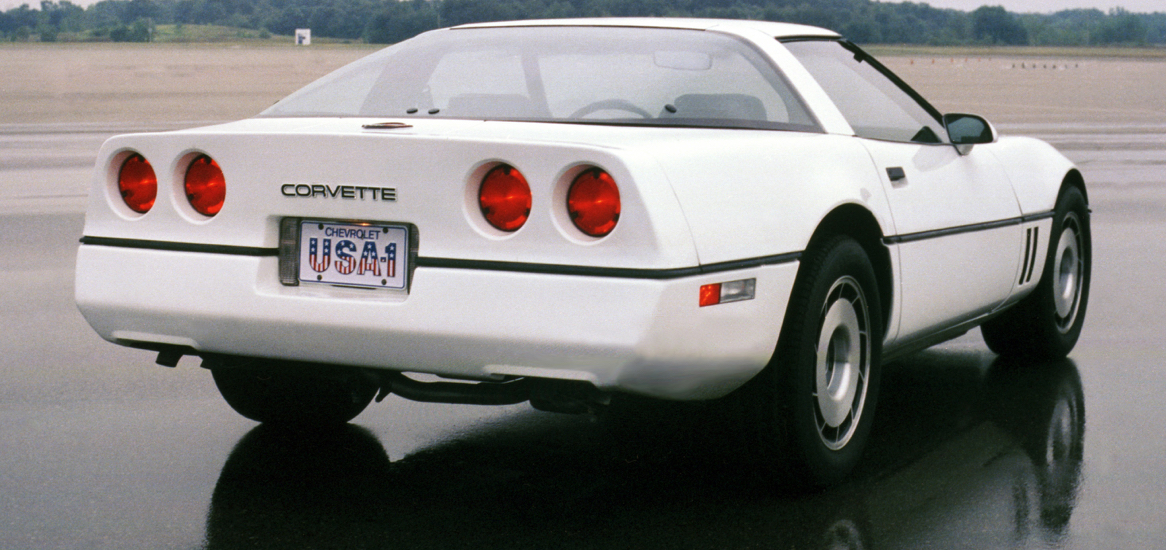
Fast-forward to the present and you’ll discover that this is no longer the case. With four-generations of Corvette now separating the C4 from its newest, mid-engine sibling, and with the refinements to both the form and function of each iteration of the car that followed the fourth-generation model, prices have never been better on Corvettes built between 1984 and 1996. In fact, purchasing a C4 is a fun-and-affordable way to indoctrinate yourself into the Corvette lifestyle – even on a budget.
But Is the C4 a “Real” Corvette?
In a word – YES!
The fourth-generation Corvette often gets overlooked by many Corvette enthusiasts simply because it arrived during a time when government-mandated safety and emission regulations as well a need for increased fuel economies forced Chevrolet to develop a version of their beloved sports car that was less about engine output and raw-power and more about handling and drivability. At the same time, the C4 Corvette was the first fully-redesigned Corvette since the 1963 Corvette Sting Ray. When it was first introduced in 1984, it was celebrated by enthusiasts for its futuristic design and its use of (then) cutting-edge technology.
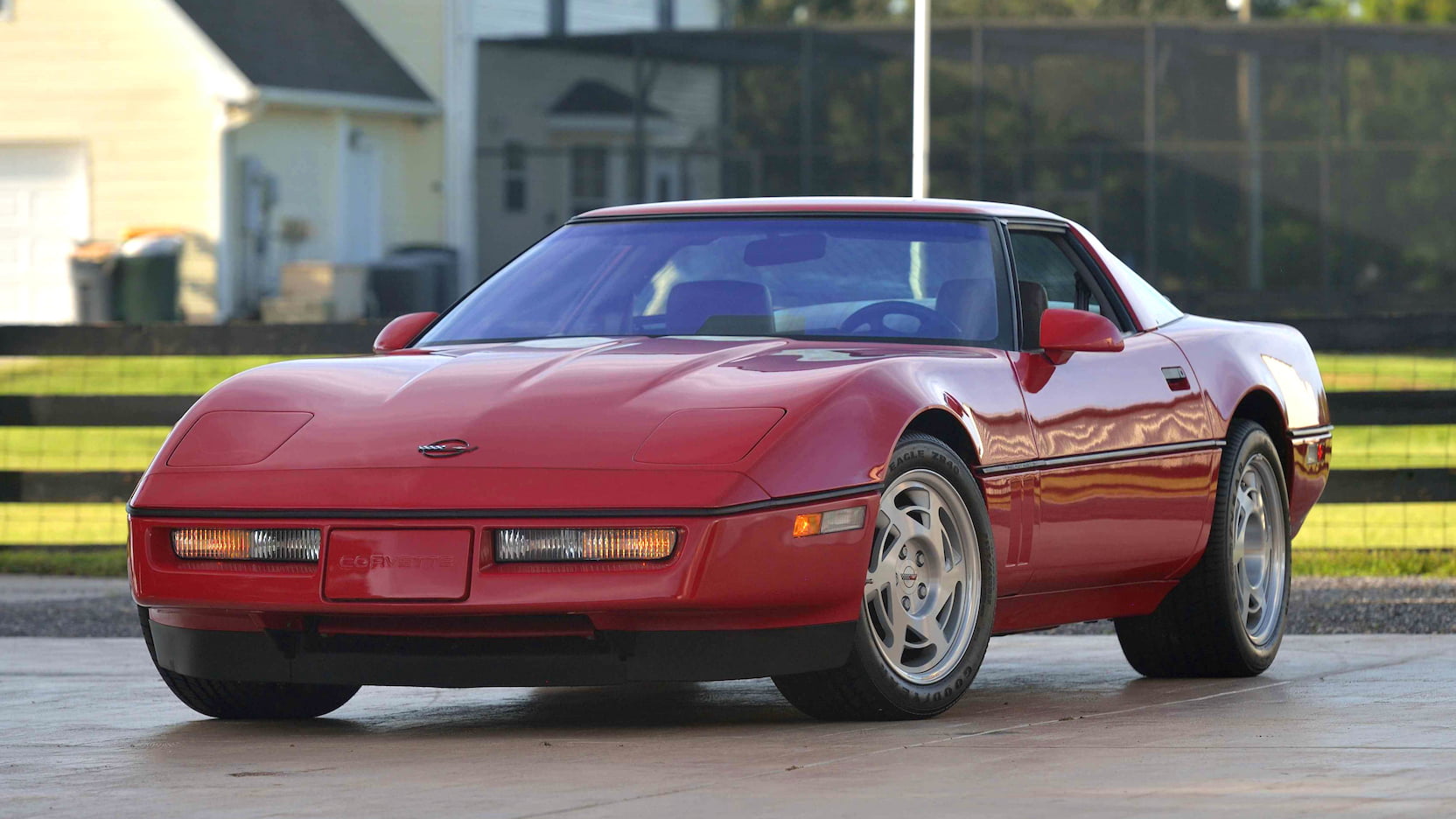
Today, the fourth-generation Corvette may look a bit dated compared to the seventh-generation Stingray or the eighth-generation mid-engine C8, but part of its appeal is that it calls back to a pivotal decade which has, thanks to shows like “Stranger Things,” found an entirely new audience who just can’t get enough of the 1980’s. Just like its predecessors, the C4 Corvette (in all its iterations) looks less dated and more “classically attractive.” While it may never be seen as “vintage,” at least not in the way a 1963 Corvette is considered as such, it nonetheless has become an iconic symbol of its era while remaining immediately recognizable as a Corvette.
Some of what makes the C4 less attractive to enthusiasts can be tied to the models that followed the fourth generation Corvette just as much as any shortcomings of the C4 itself. The arrival of the C5 Corvette brought significant advances in performance, ergonomics and build quality. These refinements helped catapult the fifth-generation Corvette onto the global stage both on-and-off the racetrack. As such, the C4 was quickly overshadowed by the improvements made to the C5 between 1997 and 2004. The C6 Corvette further advanced all the best elements of the C5, catapulting the Corvette forward as a genuine contender in European racing circuits, including the 24 Hours of Le Mans. By the time the C7 Corvette arrived in 2014, the fourth-generation Corvette was considered by many as an outdated “blip” in the history of the brand.
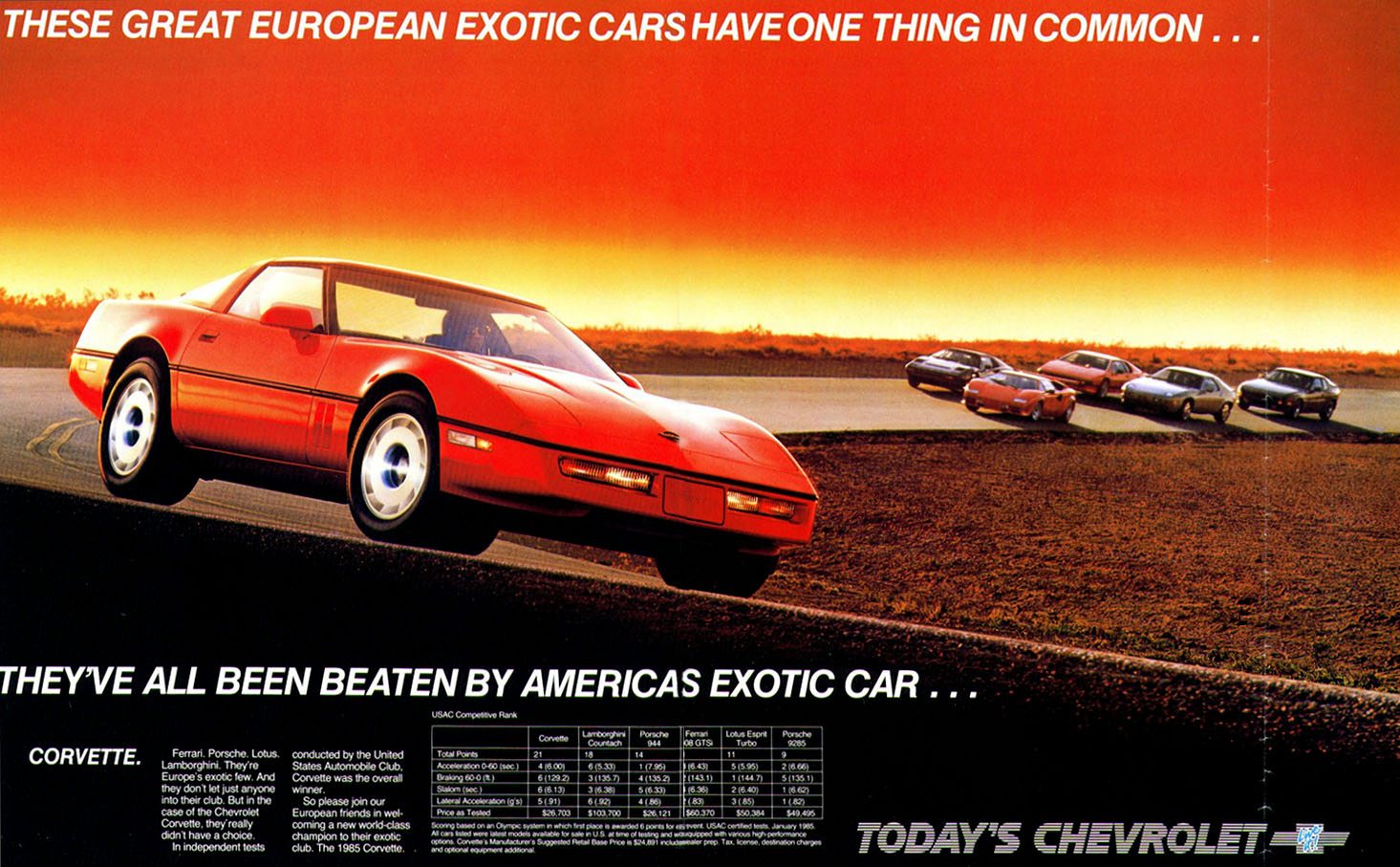
While the advances made by each successive-generations of the Corvette pulled attention away from the C4, it is a highly capable vehicle both on-and-off the track. The fourth-generation Corvette more than holds its own – as proven by the countless road racers across the country (and around the world) who continue to regularly drive them in competition. Additionally, attend any local Cars & Coffee event in your hometown. You’ll find a number of examples of the fourth-generation Corvette on display and looking as good as they did when they rolled off the assembly line in Bowling Green more than 35 years ago.
Anatomy of the Fourth-Generation Corvette – the Good, the Bad and the Ugly
There’s a lot to love about the fourth-generation Corvette. If you’ve never driven one, its a unique experience, even when compared to driving other-generations of America’s sports car. As with any car, it has its high-and-low points – it’s strengths and weaknesses if you will. While we’ll drill into the specific weaknesses you should be on the lookout for later in this article, the following topics are a general overview of all that was good, and some of what was not-so-good, about Corvettes built between 1984 and 1996.
Suspension
While structural rigidity is a given on today’s Corvettes, the body structure of the fourth-generation Corvette was somewhat less rigid, which caused some body flex, especially in the convertible models. To compensate for this, Chevrolet developed an all-aluminum suspension for the fourth-generation Corvette that was dialed in with surprisingly stiff shocks and very high spring rates. This setup gave the C4 incredible cornering capabilities, but it could also make the car extremely uncomfortable when driving it for any length of time. This rigid suspension setup was especially true of the early fourth-generation Corvettes along with those that came equipped with the optional Z51 suspension package. By 1996, Chevrolet had refined the suspension setup on the C4 and even offered consumers an optional “selective ride” setup that changed the rigidity of the ride based on driving conditions.
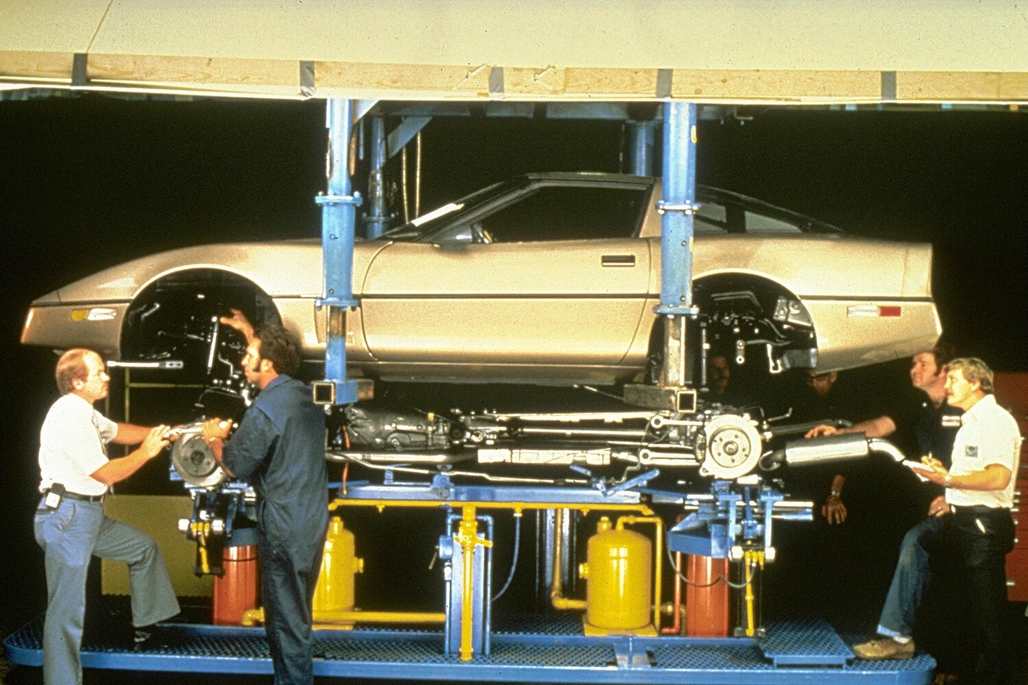
Engine/Powerplant
As you’ll see below, the powerplant that breathed life into the C4 Corvette improved throughout the lifespan of the fourth-generation model. That said, all iterations of the 5.7 liter, 350-cubic-inch small-block engine that were used between 1984 and 1996 remain some of the best regarded powerplants from that era.
When the C4 was introduced in 1984, it produced a very modest 205 horsepower. By 1996 however, Corvette was utilizing the LT1 engine and pushing north of 300 horsepower out of their cars. While all variants of the powerplants used are timid (compared to the Corvette engines being built today), the setup on these cars still gave their drivers a thrilling driving experience. Even the L98, which was used from 1984 to 1991, was surprisingly powerful (despite how it might be perceived when looking at its performance specs on paper.) In fact, the same L98 that was used in the Corvette was also the engine selected by GM to power their IROC Camaros and the Pontiac GTA Trans Am.
L83
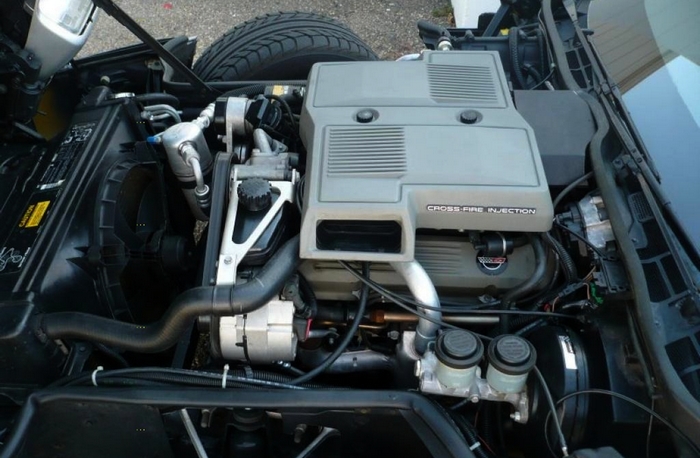
The L83 engine was introduced in 1982 for the final year of the C3 Corvette. The engine was a 350 cubic inch V8 that was rated at a modest 200 horsepower and 285 lb./ft. of torque. This engine carried over to the 1984 Corvette (there was no production Corvette built in 1983) and received a marginal increase in power. Now rated at 205 horsepower and 290 lb./ft. of torque, this engine was significant for its introduction of Cross-Fire Fuel Injection, which was actually a twin throttle-body fuel injection system.
While the Cross Fire Fuel Injection is often viewed as both “under-powered” and “temperamental,” this hybrid throttle-body fuel injection system was actually a necessary leap forward in the advances of the Corvette powerplant. There were considerable emissions requirements that had to be met and GM’s engineers were looking at ways to maintain power output while ensuring the Corvette met these requirements. While considered vastly underpowered by today’s standards, the Cross-Fire Fuel Injection system actually improved engine horsepower in 1984 (as well as in the 1982 C3 model) over carbureted iterations of the C3’s powerplant.
For anyone considering an inexpensive first (or next) Corvette, the 1984 Cross Fire Injection Corvettes are the most affordable (on average) of any used Corvette currently on the market. And while it is true that the Cross Fire Fuel Injection system has its problems – such as leaky intake manifolds, sticky IAC motors and temperamental air-injection pumps – there is also a large subset of consumers who have purchased these cars for their affordability, made some modifications to the fuel injection system, and have enjoyed driving these cars both on the open road and on the racetrack.
L98
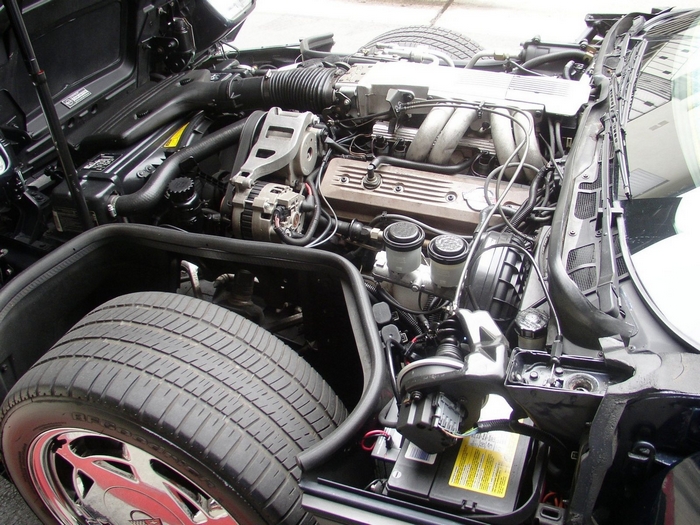
The L98 featured Tuned Port Injection (TPI), which was considered by many as Chevrolet’s first successful venture into the world of EFI (we beg forgiveness of anyone who actually appreciates the L83’s crossfire injection system.) The L98 engines featured computer-controlled ignition and fuel injection which delivered more precise control of both fuel and spark, which resulted in both better fuel mileage and a far more responsive throttle control. The L98 enabled Chevrolet to offer higher level of powers and performance while also navigating government sanctioned fuel economy regulations. Yes, its true that the L98 was certainly not the most powerful V8 of its generation, or even the most powerful V8 offered by General Motors during that time, but it still represented a huge leap forward in performance and output over the engines that had immediately preceded it. Moreover, it paved the way for even more powerful engines –such as the LT1.
LT1
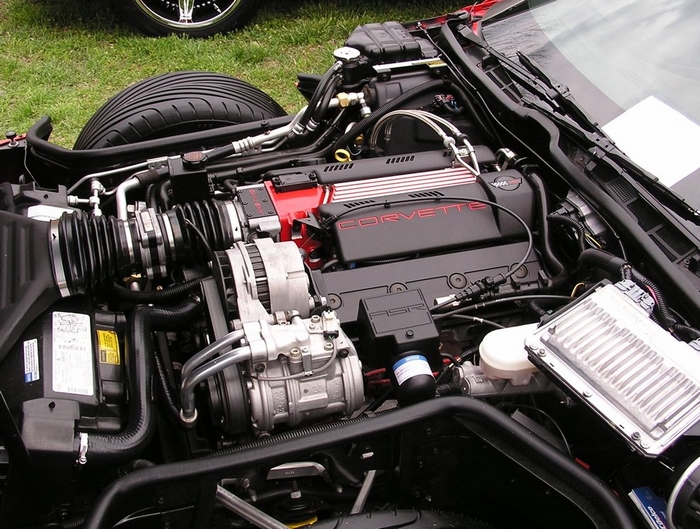
The LT1 engine replaced the L98 in 1992. Rated at 300 horsepower and 330-340 lb./ft. of torque (depending on the year), the LT1 featured a remarkable improvement in engine horsepower over its predecessor. The new engine featured Multi-Port Fuel Injection and a reverse-flow cooling system which cooled the cylinder heads first, helping the engine to maintain lower combustion chamber temperatures which allowed the engine to run at a higher compression than its predecessor.
Like the L98, the LT1 was considered a fairly reliable engine, save for one fairly common – and significant – issue that has plagued the LT1 almost since its inception in 1992 – the Optispark Ignition System.
While a traditional fuel-injected small-block Chevy V8 had the distributor mounted near the rear of the engine block, the LT1 featured anew type of optical sensor that was placed in the front of the engine. This sensor was able to “see” the LED light passing through a spinning reluctor wheel in one-degree increments. This meant that the LT1’s ECM was able to know where each piston was located at any given time and which cylinder would fire next. In turn, this allowed the ECM to make minor adjustments to ignition timing during engine operation.
While this technology was advanced for its time, its placement in the front of the engine caused the Optispark system to suffer from exposure to road water, grit and salt far more than a typical distributor. Additionally, being mounted beneath the waterpump, it would fail if/when the waterpump failed – and even a small amount of water from the waterpump weep hole would often wipe out the distributor entirely. To that end, even a split radiator hose could cost C4 owners hundreds of dollars if the leaking coolant came into contact with the distributor. Adding to this issue, the factory ventilation holes on the distributor were too small, which would result in ozone buildup and corrosion within the distributor, which could lead to engine misfires. These holes were also too small to allow water to escape, so if the Corvette sat for a few weeks, the condensation in the distributor would result in water getting trapped within the distributor cap.
Despite this one issue, the LT1 was a solid engine, with horsepower and torque to spare. While it should be noted that the Optispark ignition can cause issues with the later-model C4 Corvettes, there were many aftermarket distributors manufactured that resolved the aforementioned issues. We make mention of it here only because this issue plagued so many Corvette owners back when the C4 was new.
LT5
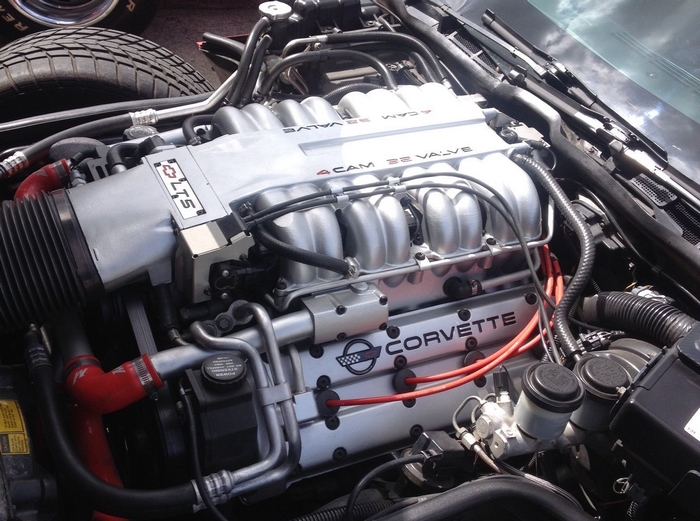
The LT5 engine was introduced in 1990 and was released by Chevrolet as the powerplant for the C0rvette ZR-1. The LT5 engine featured a Lotus Engineering-designed double overhead cam, 350 cubic-inch engine rated at 375 horsepower and 370 lb./ft. of torque for the 1990–1992 Corvette ZR-1’s and 405 horsepower and 385 lb./ft. of torque for the 1993–1995 Corvette ZR-1’s. The jump in power rating on the later engines was due to cam-timing changes and improvements to engine porting. The 1993 engine also added 4-bolt main bearing caps and an exhaust gas re-circulation system.
Everything Else
While very few of us would say that the C4 Corvette was perfect, there were/are a lot of nuances to the car that have become an important part of its character and charm. For example, the C4 has some of the largest and widest door sills of all eight-generations of Corvette. The sills had a lot more to do with function than the car’s form, and getting into and out-of a fourth-generation Corvette is anything but graceful, yet the design adds a distinctive “1980’s aesthetic” to the car that plays to the same “excess” that abounds in everything from that era.
The entire design of the C4 was far more understated than its predecessor. Where the C3 Corvette drew heavy design influence from the Mako Shark II concept car, with its swooping front fenders and its countered cockpit, the C4 was more subdued by comparison with an emphasis on deliberate bodylines that were functional as well as fashionable. The C4 was the first-generation of Corvette to shift its focus to the “form follows function” design process.
Unlike the body-on-frame construction practices used on earlier Corvettes (up to and including the 1982 C3), the C4 Corvette utilized a uniframe sub-assembly design. Uniframe fabrication combines critical elements of the car, including the cars’s windshield, into a single, welded unit.
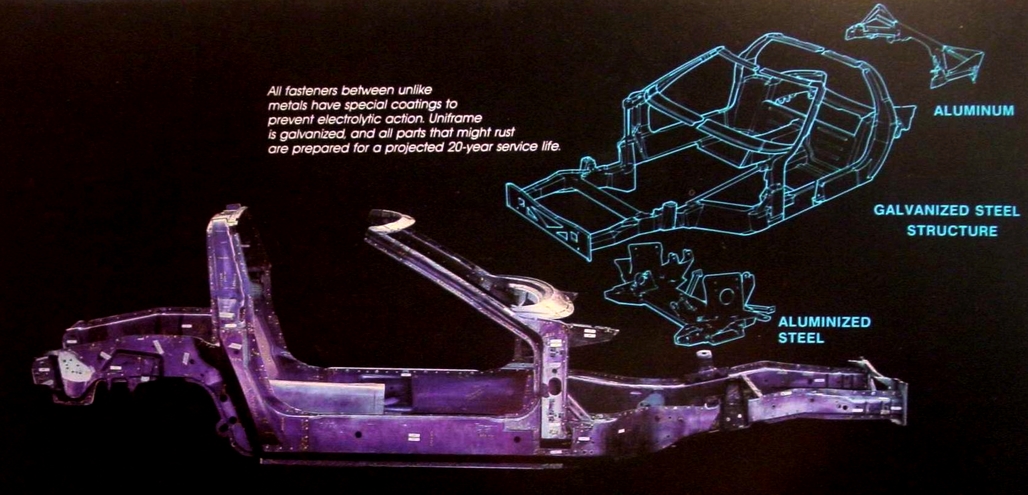
Lastly, instead of utilizing a two-piece T-top construction for its removable roof panels on coupe models, the C4 Corvette featured a single-piece removable targa top. The larger, single piece assembly enabled drivers a more open, less restrictive view while driving with the top off. Thanks to advances made in the rigidity of the unibody frame, the removable targa top became the standard on all-generations of Corvette coupes from 1984 onward.
Year By Year – What Are the Differences?
1984
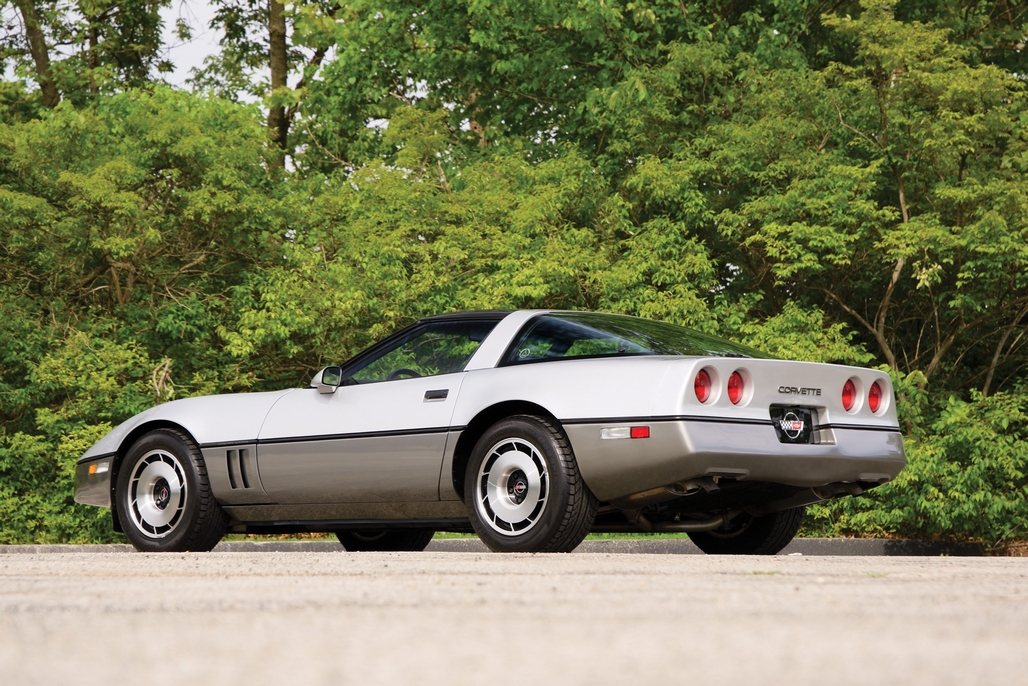
While Chevrolet had originally intended the C4 as a 1983 model year vehicle, changing emissions standards and a desire not to rush into production caused a year-gap between the outgoing C3 and the arrival of the fourth-generation C4 Corvette.
The 1984 Corvette is unique in that it features the same “Cross-Fire Injection” engine that was introduced in the 1982 Corvette. Designated L83, the 350 cubic-inch engine was rated at just 205 horsepower. Unlike the C3, which could only be ordered with an automatic transmission, the 1984 Corvette could also be ordered with a Doug Nash 4+3 manual transmission, although this option did not arrive until late in the production year. As a result, just 6,443 Corvettes were equipped with this gearbox in 1984, making the pairing a fairly rare combination today.
More common was the inclusion of the Z51 performance suspension upgrade, an option which included heavy-duty front and rear springs, shock absorbers, stabilizer bars and bushings, a faster steering ratio, an engine oil cooler, and extra radiator fan, P255/50VR16 tires and directional alloy wheels (16 x 8.5- inch in the front and 16 x 9.5-inch in the rear.) More than half of the 1984 Corvettes built that year came equipped with the Z51 option (25,995 units total.) While a popular option for performance driving, this setup made for a very unforgiving ride on any surface that had even minor imperfections to it.
Despite its limited horsepower and unrefined handling, the 1984 Corvette proved to be a huge sales success when new. Because Chevrolet did not present a 1983 Corvette to the buying public, the 1984 Corvette was introduced in March, 1983, resulting in the longest single-year production run of any model Corvette built before or since. The outcome of this long run was that the 1984 Corvettes became the second-highest produced Corvette of all time, with 51,547 units sold that year.
While the Cross-Fire Injection system may be considered undesirable to many, a well-maintained 1984 Corvette will likely be one of the most affordable Corvettes on the market today, with many examples selling for $8,000 or less.
1985
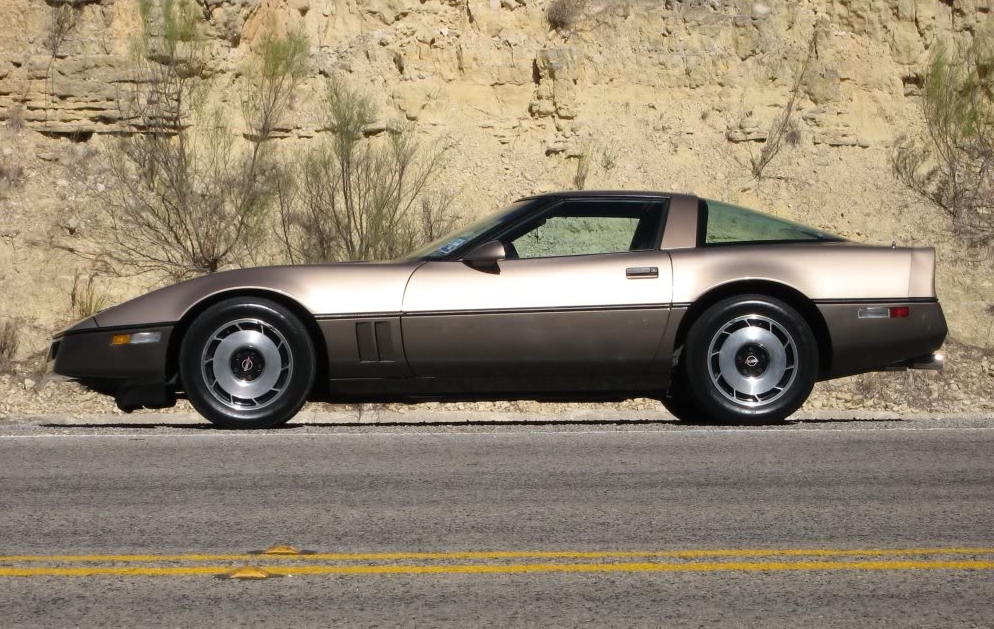
While the overall aesthetic of the car remained largely the same from 1984 to 1985, the sophomore model of the C4 Corvette saw a significant refinement – the replacement of the L83 Cross-Fire Injected Engine with the 230-horsepower L98 engine with Bosch Tuned-Port Fuel Injection. In addition to the respectable bump in horsepower, the 1985 Corvette’s torque output also increased from 290 lb-ft of torque to 330 lb-ft.
As the unforgiving ride of the aforementioned Z51 suspension was definitely a concern for many consumers, Chevrolet addressed the issue with a 25 percent reduction in spring rates and the inclusion of 9.5-inch wheels all around. The 1985 Corvette also received Delco-Bilstein gas-charged shock absorbers and thicker stabilizer bars.
Corvettes equipped with a manual transmission that year received a new, heavy-duty 8.5-inch ring differential. Rear axle gearing ratio for manual transmission models was 3.07:1. Standard gearing ratio for automatic transmissions was 2.73:1 although the optional, higher gear ratio could be ordered on cars equipped with an automatic as well via RPO G92.
These new features improved the car’s overall performance between the 1984 and 1985 models and resulted in another year of large sales numbers. In 1985, Chevrolet sold 39,729 Corvettes.
1986
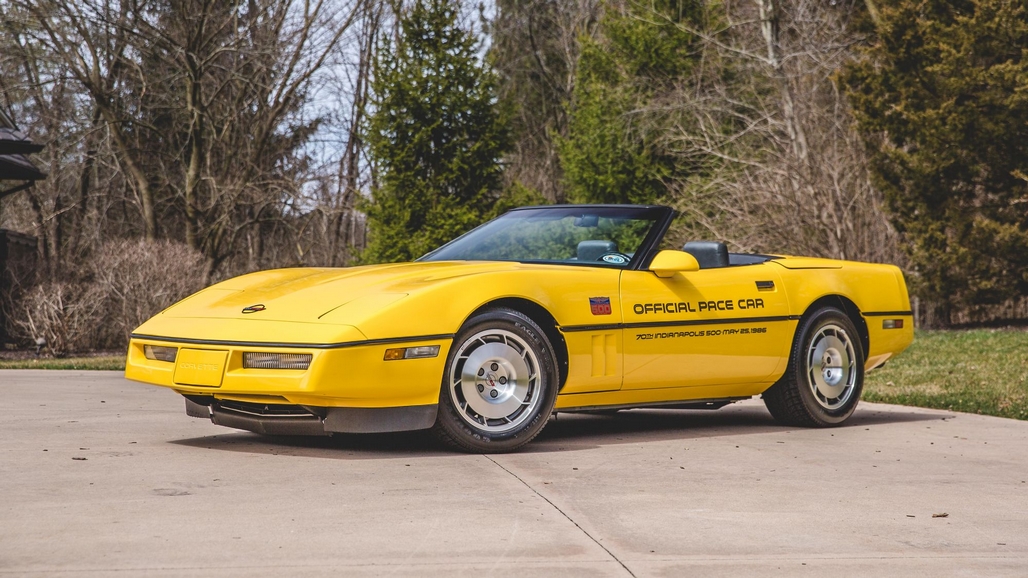
Arguably the biggest announcement for the 1986 model year was the return of a Corvette convertible, an option that hadn’t been available to consumers since 1975. In commemoration of the return of the convertible, the 1986 Corvette was selected to serve as the official pace car for the 70th running of the Indianapolis 500. All 7,315 convertibles produced that year were considered “pace car” replicas, regardless the color selection of each car.
A new Vehicle Anti-Theft System (VATS) was introduced with the 1986 Corvette. Cars now required a special VATS key that featured a unique unique ignition key with a black, embedded pellet. The ignition lock cylinders could measure the electrical resistance of the pellet (there were 15 different pellets in all) and served as a secondary means of verifying that the ignition key was the correct one for the car.
Fifty Malcolm Konner Commemorative Edition Corvettes were produced in 1986 as well. These cars were built to commemorate the New Jersey Chevrolet dealership’s founder, Malcolm Konner. All fifty of the cars were coupes and all featured a special, two-tone paint scheme, silver-beige over black and all of them had graphite leather interiors.
Horsepower on the 1986 Corvette was increased to 235HP. The L98 featured new, aluminum cylinder heads. The car also included anti-lock brakes (ABS) and a center-mounted brake light as standard features. Despite the return of the convertible model, total sales of the 1986 Corvette dropped by roughly 11,000 units to just 27,794 cars sold that year.
1987
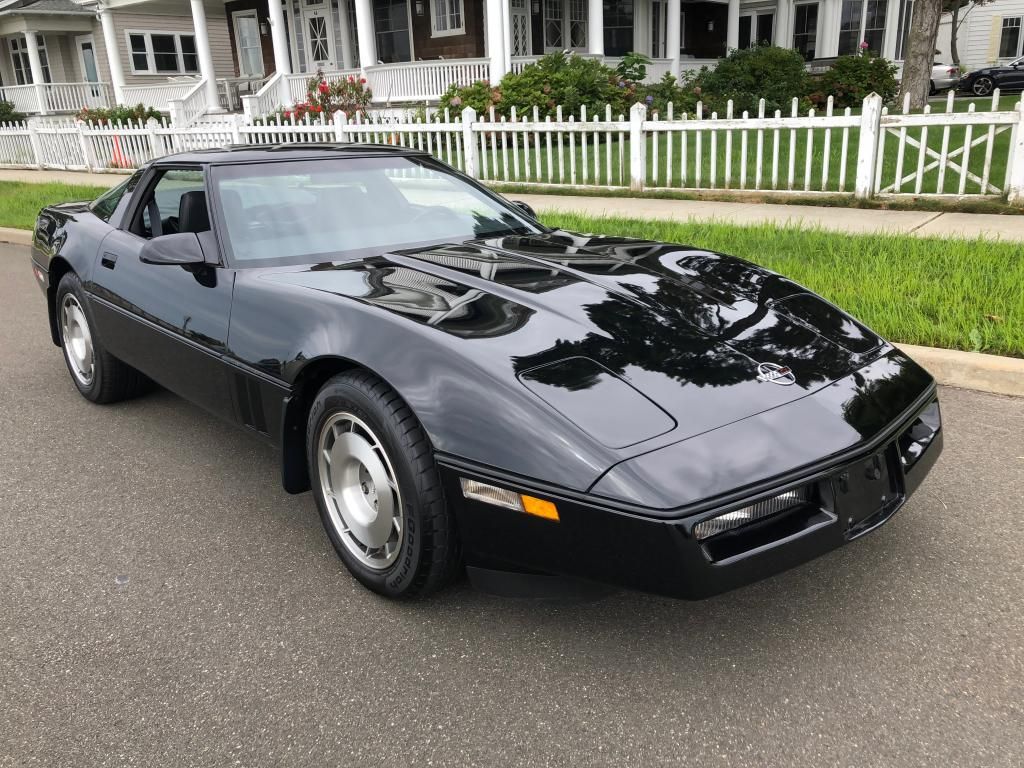
The 1987 Corvette was ranked by “Car and Driver” magazine as one of the top-ten cars that year. It was also recognized by “Motor Trend” magazine as the winner of the top speed, best braking and best skidpad categories for the 1987 model year.
The most significant mechanical upgrade made to the 1987 Corvette was the introduction of new roller valve lifters which boosted the L98 engine’s output to 240 horsepower, which was a 5 horsepower bump over the 1986 Corvette.
The biggest announcement for 1987 was the introduction of regular production option (RPO) B2K. This $19,995 upgrade was not a factory installed option, but rather an “aftermarket” upgrade performed by Callaway Engineering. Fully assembled Corvettes were shipped from the manufacturing plant in Bowling Green, Kentucky to Callaway Engineering in Old Lyme, Connecticut for modifications to the engine which included the installation of a twin-turbo system to the factory engine. When so equipped, it boosted the car’s horsepower output to 345hp and 465lb./ft. of torque. All 1987 Callaway Corvettes were equipped with manual transmission and none were certified for sale in California. A total of just 188 twin-turbo Corvettes were built in 1987. Of these, 123 were coupes and 65 were convertibles.
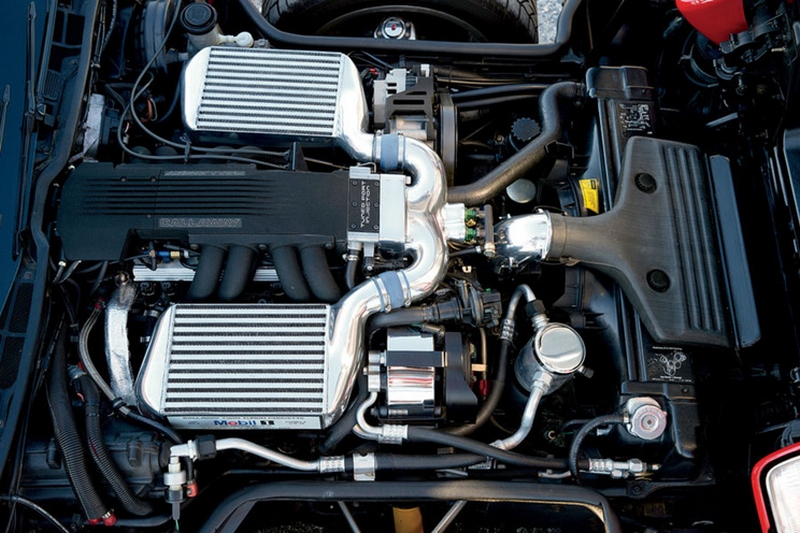
The other big news for 1987 was the introduction of a new Z52 sport-handling package. It combined elements of RPO Z51 with the softer suspension of base model Corvettes. RPO Z52 included a radiator boost fan, Bilstein shock absorbers, an engine oil cooler, a heavy-duty radiator, 16×9.5-inch wheels, a faster 13:1 steering ratio, larger front stabilizer bars and the convertible-inspired upgrades also introduced with RPO Z51 in 1987 which fortified the structural rigidity of the convertible Corvette’s frame.
Total Corvette sales improved for the 1987 model year with a total of 30,632 Corvettes produced. Of these, 10,625 were convertible models.
1988
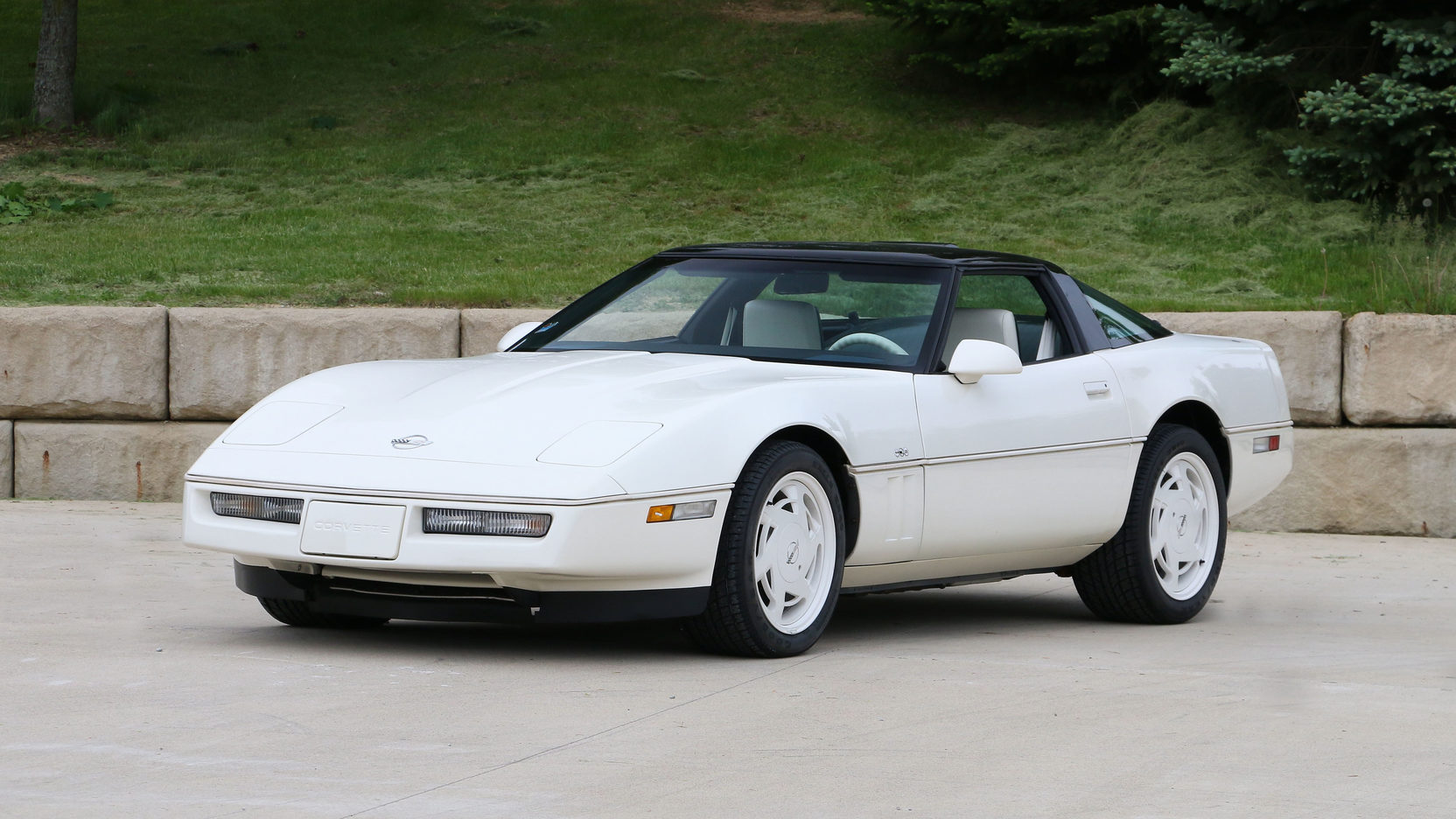
The 1988 model year marked the 35th anniversary of the Corvette. Chevrolet celebrated the anniversary by creating a special-edition trim package which was limited to just 2,050 examples. The 1988 35th Anniversary Corvette featured white paint with a black roof bow, a white leather interior (including a white steering wheel and white leather seats), white painted wheels and unique badging commemorating Corvette’s 35th anniversary. The option (RPO Zo1) was only available on coupe models of the car.
The 1988 Corvette offered consumers a number of other new options including: carpeted door sills, solution-dyed carpet, improved “flow through” ventilation for the coupes and a lower, rearward relocation of the parking brake handle. In addition, improvements to the braking system now included new dual-piston front brakes and parking brakes which activated the rear disc brake pads instead of activating small, separate parking drum brakes (as had been standard on all earlier models.) All 1988 Corvettes also received improved hood support rods and a more efficient air conditioning compressor.
The features included in RPO Z51 and Z52 changed some for the 1988 model year. Both had newly styled 17×9.5-inch wheels with twelve cooling slots and P275/40ZR17 tires. The Z51 had higher spring rates and a finned power steering cooler as before but it also received larger front brake rotors and calipers. RPO Z51 was limited to manual transmission coupes. RPO Z52 was not restricted.
1989
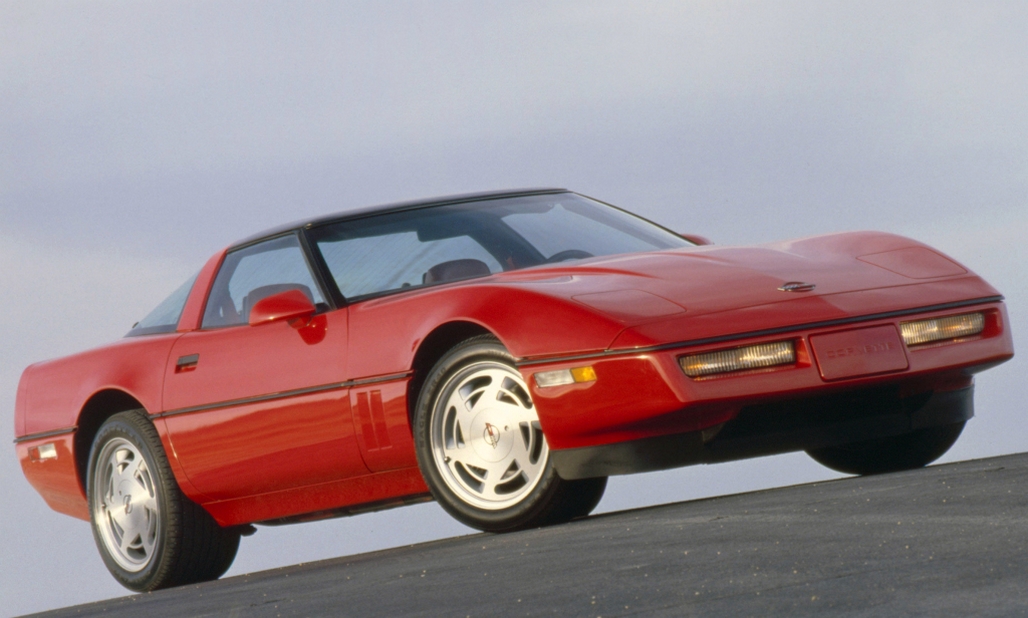
The most significant change to the 1989 Corvette was the introduction of the ZF (Zahnradfabrik Friedrichshafen) sourced six-speed manual transmission. The transmission, which could be ordered under RPO MN6, was a no-cost option on the Corvette. It featured a computer-aided gear selection (CAGS) which bypassed second and third gears (and locked out fifth and sixth) for improved fuel economy when a series of low-performance criteria were met.
The standard six-slot 16×8.5-inch wheels that had been introduced in 1988 were discontinued for the 1989 model year. The twelve-slot 17×9.5-inch wheels that were offered in 1988 as part of the Z51 and Z52 packages became the standard wheel on all Corvette models.
The Z52 option was discontinued in 1989 as well. It was replaced with a new “Selective Ride and Handling System” (RPO FX3). It was only offered to consumers when purchasing a Corvette with a manual transmission and/or cars equipped with the RPO Z51 “Performance Handling” package. The Selective Ride Control system offered consumers three different driving modes: tour, sport and performance.
Another significant Corvette milestone that actually began in 1989 was the introduction of the Corvette ZR-1. Just eighty-four prototypes were built in 1989, and while production would not officially begin for another year, 1989 is remembered for being the year that the “King of the Hill” arrived.
Despite the significantly improved manual transmission and the number of other minor, though important, refinements made to the Corvette, only 26,412 units were sold that year. This number is disappointing when you consider this is just over half of the total number of C4 Corvettes sold five years earlier when the model was introduced in 1984.
1990
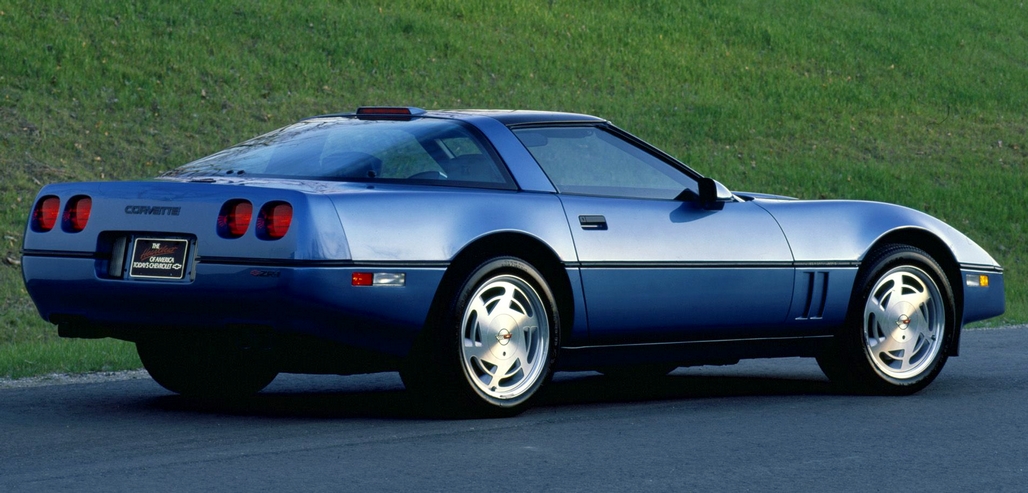
The arrival of the ZR-1 “King of the Hill” Corvette as a production model was the big news for the 1990 model year. The car featured a GM spec, Lotus-designed 32-valve, dual-overhead-cam, 350 cubic inch V8 engine. Designated the LT5, it was rated at 375 horsepower. While fairly modest compared to modern Corvettes, the LT5 was a powerhouse in its day. In addition to providing a major bump in horsepower over the base coupe and convertible models, the ZR-1 also included new body styling from the car’s B-pillar back. The car featured a wider rear fascia that was specifically designed to house the massive 315/25ZR17 rear wheels/tires. The fascia also included new body-styling, featuring a convex rear (as compared to the concave rear fascia on all C4 Corvettes to that point.)
While the ZR-1 dominated most conversation in the Corvette community, the engineers and designers at Corvette remodeled the interior of all Corvettes for the 1990 model year. The car now featured a new, hybrid instrument cluster which featured a digital speedometer and analog instrument gauges. Also gone was the flat dashboard in favor of a more contoured one that now also housed a passenger front airbag.
Chevrolet sold a total of 26,412 Corvettes in 1989 of which 3,049 were equipped as the ZR-1 model. While these sales numbers were still south of earlier model years, it proved that the arrival of the ZR-1, despite its hefty pricetag, had bolstered interest in the Corvette once more.
1991
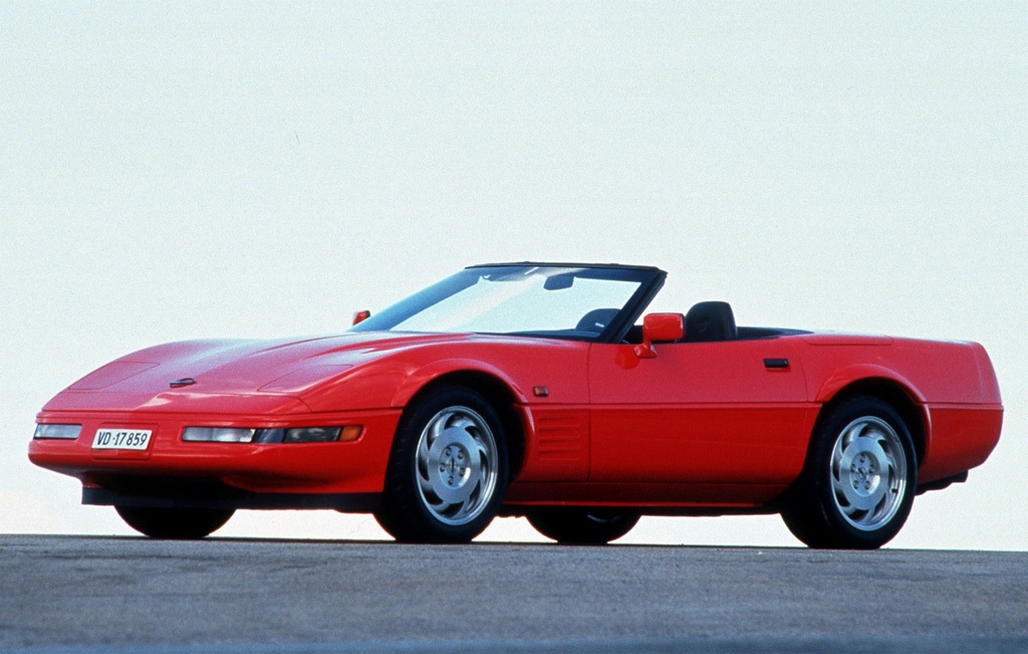
For 1991, the Corvette’s exterior received many design enhancements, including a smoother, slimmer front fascia with wraparound parking/cornering/fog lights, wider body-side moldings that were now painted to match the body color, and horizontal front-fender strakes that replaced the previous gill-like louvers. Additionally, the 9.5 inch wide aluminum wheels were re-designed and now featured a turbine-like appearance.
In addition to the refinements to the car’s exterior, the 1991 Corvette also provided consumers some new options. RPO Z07 was introduced and included the Z51 suspension components (that had been previously introduced in earlier model years) and the FX3 adjustable ride option. The latter of these enabled drivers of the 1991 Corvette the option of adjusting the car’s suspension to accommodate various driving conditions. From a consumers standpoint, it made the car’s ride go from stiff to VERY stiff.
While not a feature of the car exactly, 1991 marked the last year for the L98 350 V8 engine. Sales numbers of the 1991 Corvette struggled, despite the return of the ZR-1 for its sophomore year of production. In total, Chevrolet sold just 20,639 Corvettes in 1991. Of these, just 2,044 were sold with the ZR-1 upgrade.
1992
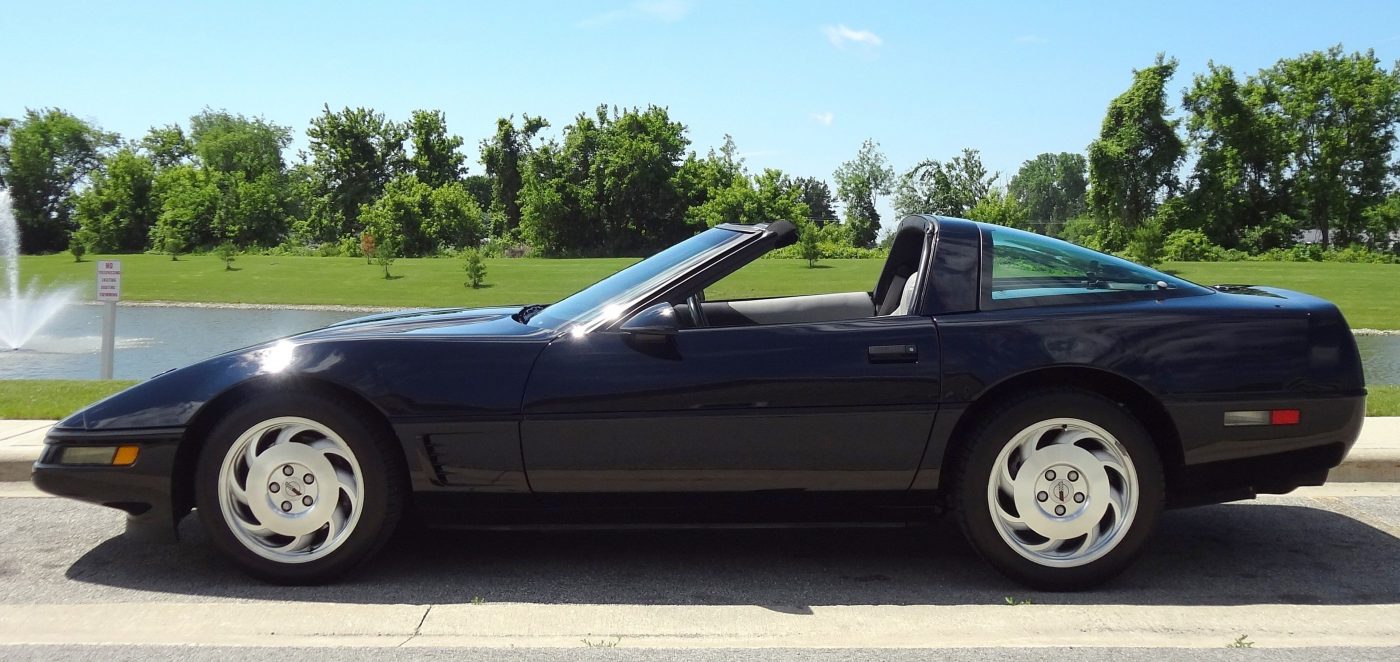
The 1992 Corvette ushered in the era of the LT1 small-block V8 engine. This 5.7-liter, 350 cubic inch engine produced an impressive 300 horsepower and 330 lb./ft. of torque, which was a remarkable improvement over the previous year’s L98 engine, despite being approximately twenty pounds heavier than the former powerplant.
A new traction control system was introduced in 1992 as well. Known as “Acceleration Slip Regulation” (RPO ASR), the system helped prevent the drive wheels from spinning unnecessarily while on slippery surfaces or when the power coming from the engine caused unnecessary wheel spin. It was designed to improve directional control with better traction during high-speed cornering.
Elsewhere on the car, a number of refinements were made, including:
- Improved weather stripping and added insulation were added to keep the car’s cockpit both drier and quieter
- The instrument panel was updated to include all black buttons and easier to read instrumentation.
- The passenger door now triggered the power cutoff to the car’s accessories when opened.
- On the ZR-1 models, brand emblem/badging was added above the car’s gills on the front fenders.
An important milestone was achieved during the 1992 model year – the one-millionth Corvette rolled off the assembly line on July 2, 1992. The car would go on to be displayed at the National Corvette Museum. Sadly, the car was destroyed during the sinkhole which opened up in the Museum’s Skydome on February 12, 2014.
Total production of the 1992 Corvette was just about the same as the previous model year with just 20,974 units produced. Of these, 502 were ZR-1 Corvettes.
1993
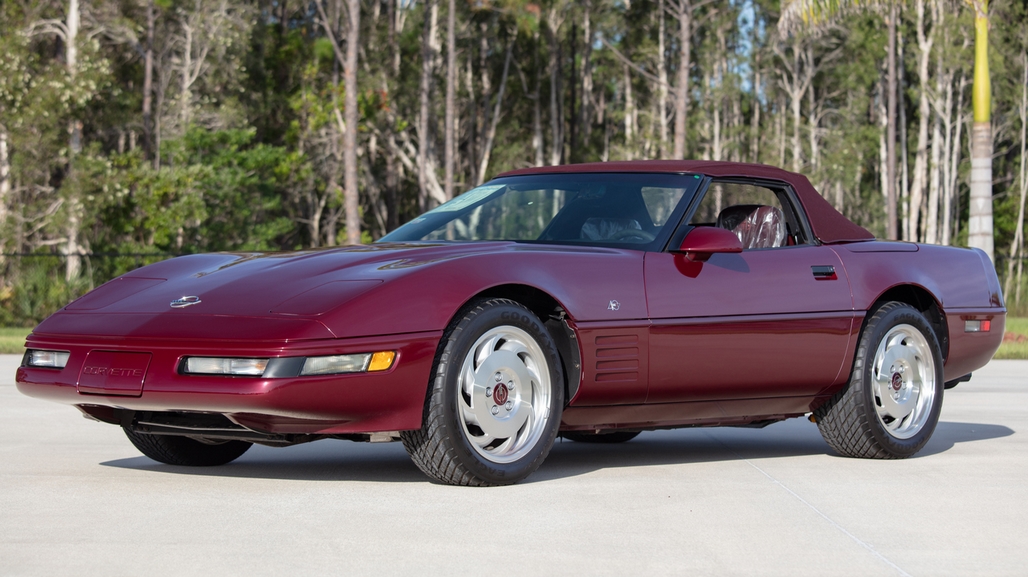
The 1993 Corvette marked another significant milestone for the Corvette- its 40th Anniversary! As with other milestone years, Chevrolet developed a special edition 40th Anniversary Package which was available on all variants of the car including the ZR-1. The 40th Anniversary package included a Ruby Red metallic exterior, special “40” badging on the front fenders and special badging on the hood, Ruby Red leather sport seats with “40th” embroidered headrests, a power driver seat and special wheel center caps finished in Ruby Red with the Corvette emblem emblazoned on it. In reality, all 1993 Corvettes included the embroidered headrests, regardless of paint/color scheme.
The 1993 Corvette was the first automobile sold by General Motors to feature the passive keyless entry (PKE) system. Working by proximity, a battery-operated key-fob transmitter sent a code picked up by a receiver in the Corvette through one of two antennas (in the coupes, the antenna was in the driver door and rear decklid, in convertibles, the antennas were in both doors.) The transmitter required no specific action by the owner. When a person with the fob approached the car, the transmitter would unlock the doors, turn on the car’s interior light and disarm the theft-deterrent system. Similarly, when leaving the car with the fob, the transmitter would lock the doors and arm the theft-deterrent system. Additionally, Corvette coupes had an extra button to release the rear decklid.
The front wheels on the base coupe and convertible were decreased in size from 9.5×17 to 8.5×17 and the front tire size from P275/40ZR17 to P255/45ZR17/ Rear tire size was increased from P275/40ZR17 to P285/40ZR17. For cars equipped with PRO Z07, 9.5×17 wheels and P275/40ZR17 tires were used for both front and rear wheels. A new, polished version of the “turbine” wheel was introduced as the standard wheel for the 1993 Corvette.
The 1993 Corvette ZR-1 received a respectable boost in power from 385 horsepower to 405 horsepower. The car’s torque was improved from 370 lb./ft. to 385 lb./ft.
Total production of the 1993 Corvette was better than the previous years, though still lackluster compared to the early years of the C4 Corvette. In total, 22,048 Corvettes were produced. Of these, just 448 were built as ZR-1 Corvettes.
1994
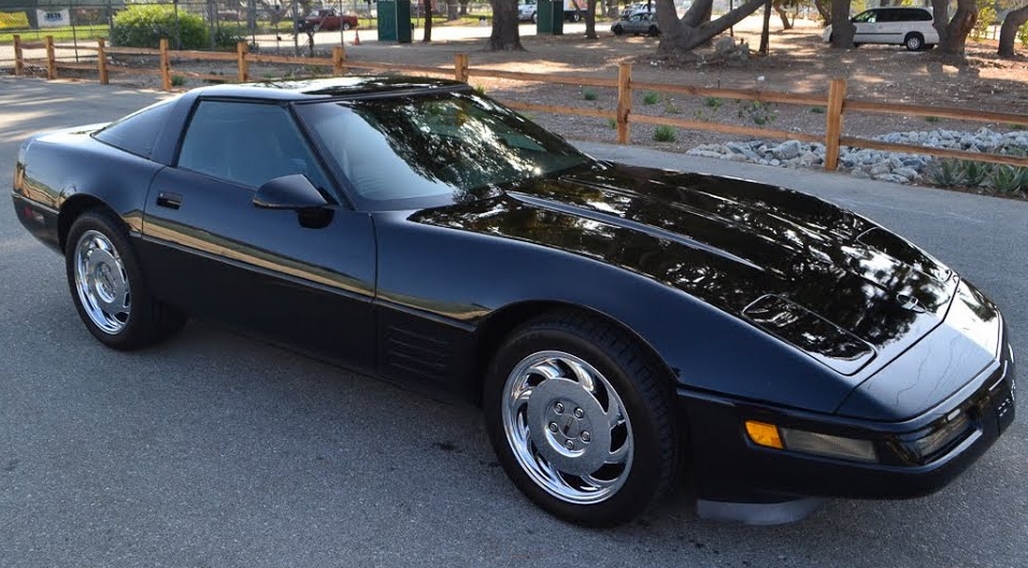
There were few changes made to the Corvette for the 1994 model year. The LT1 engine remained at 300 horsepower though sequential fuel injection was added. The SFI improved engine idle, overall drivability and emissions output by firing the fuel injectors in sequence with the engine’s firing order.
The standard four-speed automatic transmission was updated to include electronic shift control for improved performance. Additionally, a lockout switch was installed on the new automatic gearbox which required drivers to depress and hold the brake pedal before shifting out of “park”. This last addition was installed as a response to industry concerns regarding “unintended acceleration.”
There were no cosmetic changes made to the exterior of the 1994 Corvette. The only visible difference that differentiated the 1994 Corvette from earlier years was the introduction of two new colors – Admiral Blue and Copper Metallic (although Copper Metallic was limited to only 116 cars due to limited availability).
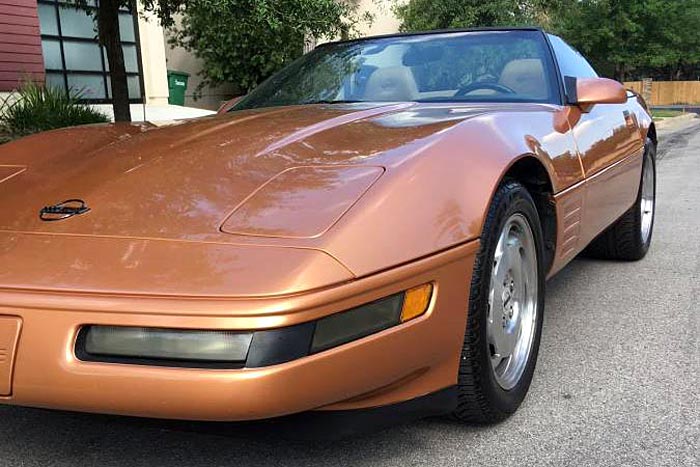
For the ZR-1 Corvette, non-directional, five-spoke wheels were introduced and included as part of the RPO ZR1 package option. These wheels were not made available on the base model coupe or convertible.
Another important milestone in the history of the Corvette was the opening of the National Corvette Museum in Bowling Green, Kentucky. The NCM opened on September 2, 1994 directly across the street from the Corvette Assembly Plant. While the opening of the Museum probably had little do with Corvette’s sales numbers, the 1994 Corvette actually saw a decent uptick in total units sold at 23,330 examples, of which 448 were sold as ZR-1 Corvettes.
1995
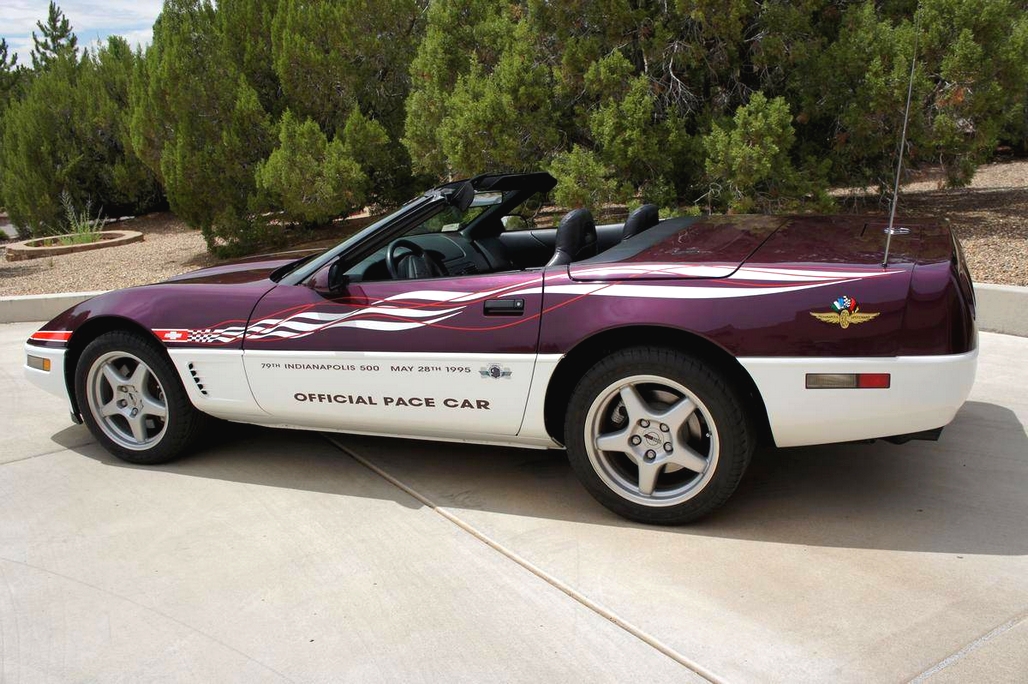
By the time production began on the 1995 Corvette, much of the engineering team behind the brand were already engaged in testing the fifth-generation (C5) model. So, for its second-to-last model year, the 1995 Corvette received only minor enhancements.
That’s not to say that there weren’t any changes made to the 1995 Corvette. Mechanically, the already robust LT1 engine received additional refinements. The connecting rods were revised to improve strength and weight uniformity, the engine fan was made quieter, and the fuel injection system was improved to utilize alcohol-blend fuels, which began to have an increased appearance at gas pumps.
The six speed manual transmission was also upgraded to include a high-detent operation (which took the place of the 1994 Corvette’s reverse lockout) for easier operability. Heavy-duty ZR-1 brakes were made standard on all models, and every model also received a brand new Bosch V ABS (Anti-lock brakes) Traction Control System. All 1995 Corvettes also received a ride improvement with the introduction of the less-stiff DeCarbon gas-charged shocks.
Whereas the 1994 model year had recessed slats behind its front wheel, the ’95 model was much more refined, with a slightly flared cowling around the vents. Beyond this single physical change, the only other cosmetic differences involved the introduction of a new paint color – Dark Purple Metallic, which replaced the depleted Copper and Black Rose metallic paints.
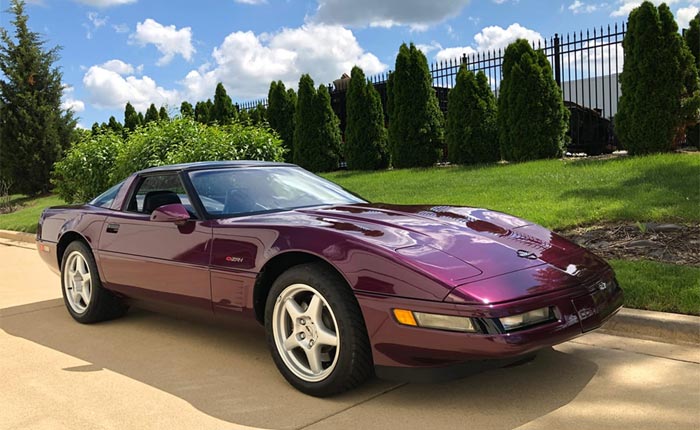
Another special-edition Corvette was made available in 1995. After a near-stock LT1 Corvette Convertible paced the Indy 500 in 1995 – which was only the third time Corvette had ever been bestowed with this honor – Chevrolet decided to commemorate the occasion by producing a specially optioned Pace Car Replica. Option RPO Z4Z was offered to consumers at an extra cost of $2816 and was limited to convertibles.
The last C4 ZR-1 was driven off the assembly line on April 28, 1995, resulting in a total number of 6,939 units being built during its six year production run. As for the base coupe and convertible, the total sales numbers decreased to 20,742 units for the model year.
1996
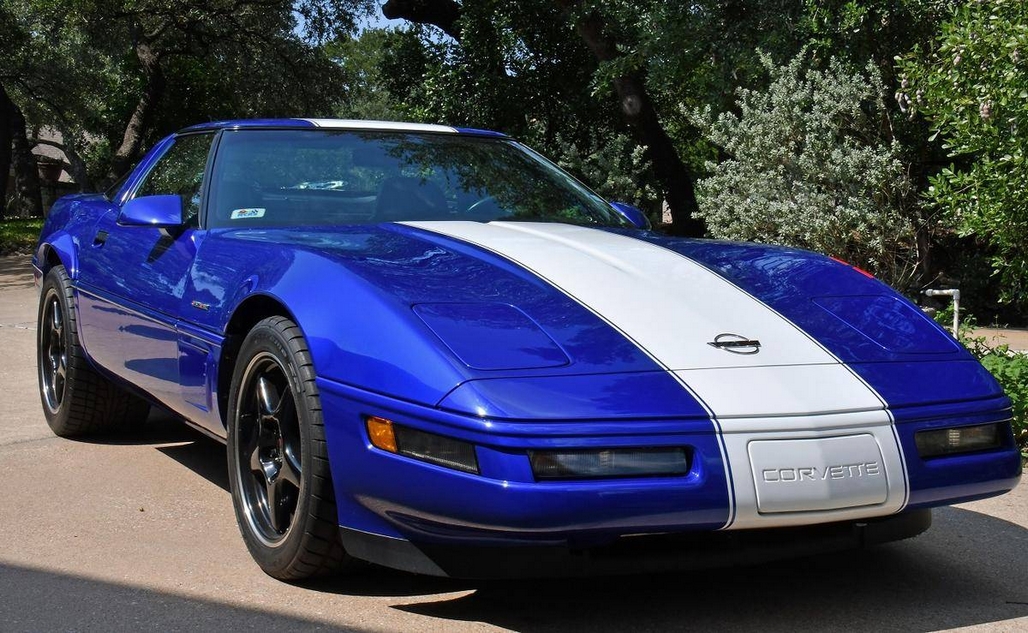
The 1996 model year would mark the final year of both the C4 and the Generation II small block engine that powered it. As such, Chevrolet commemorated its departure by offering two special edition Corvettes, both of which featured an upgraded version of the LT1 power plant. Denoted as the LT4, the 330-horsepower engine was showcased in both the Collectors Edition Corvette and a limited edition Grand Sport Corvette, but only when equipped with the six-speed manual transmission option.
The Special Edition Corvette, which included a special Sebring Silver paint color, 5-spoke matching alloy wheels with special “collector edition” wheel cap centers, perforated sport seats accentuated with “Collector Edition” embroidery, black brake calipers with “Corvette” lettering, and a special trim package featuring chrome “Collector Edition” badges, the 1996 Collector Edition Corvette was solely designed to help honor the end of the C4 era. It would be made available to consumers as both a coupe and a convertible.
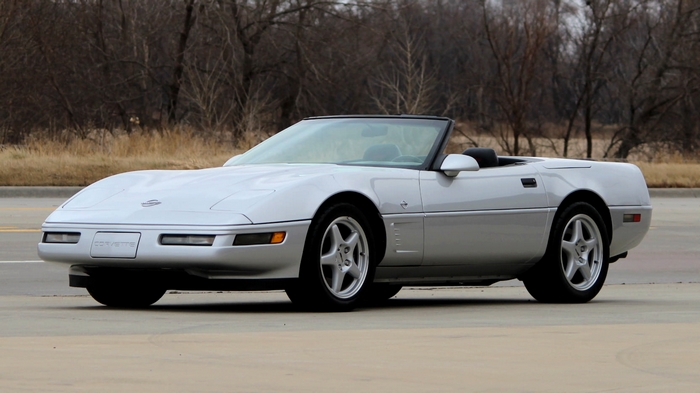
Priced at an additional $3250 for the coupe or an additional $2880 for the convertible, the Grand Sport package included exclusive Admiral Blue paint and featured a single white stripe that ran the length of the body as well as two red accent stripes (also known as “Sebring Stripes”) on the driver side front fender. This unique paint scheme was deliberately developed by GM to pay homage to the classic Corvette Grand Sport Racer of the 1960’s.
The Grand Sport’s interior upholstery was offered either in an all black or a sporty red/black combination, and all of the Grand Sport interiors featured a specialized embroidered headrest which featured the Grand Sport emblem. All Grand Sports –both coupes and convertibles- were equipped with a six speed manual transmission.
Selective Real Time Damping was introduced to replace the previous Selective Ride suspension option. Available under option code RPO F45, the Real Time Damping suspension calculated the optimal damping mode for its custom shock absorbers to maintain ride and handling quality via data that was gathered from individual sensors at each of the four wheels. This system could alter the load level/resistance of each shock individually, and it made these adjustments at intervals of once every 10 to 15 milliseconds, which translates roughly into approximately 1 (one) foot of road traversed when travelling at a speed of approximately 60 miles per hour.
Chevrolet built a total of 21,536 Corvette in 1996.
The C4 Corvette Buyers Guide
Before beginning the hunt for that perfect example of a fourth-generation Corvette to purchase, there are a few things that must be looked at critically.
First, it is important to know what good looks like. “Good” is definitely the operative word here, because lets face it, there are hundreds (if not thousands) of C4 Corvettes out there that have been abused, neglected or ignored completely. It is paramount that you avoid them when performing your search. While there is no shortage of used C4 Corvettes on the market today, being selective during the decision-making process could be the difference between enjoying a relatively maintenance-free owernship experience and purchasing a vehicle that requires endless upkeep and repairs.
Know What To Look For Before You Begin Looking

To be forewarned is to be forearmed.
You are going to be looking at cars that – best case (if built in 1996) are nearly 24 years old (at the time this content was written.) Go all the way back to 1984, and you are looking at a car that is nearly 36 years old. In both cases, it is important to know what to look for before you even consider visiting a dealership or private owner to look at a used C4 Corvette. This following list of items is not all-inclusive, but it will help you find you navigate your way as you sift between someone’s shadetree restoration project and a well preserved piece of Americana.
Tires
While it’s true of any car, looking at the treadwear of the tires is an excellent place to begin evaluating a prospective Corvette. Tires are expensive to replace and its commonly known that a seller will avoid putting new tires on a car if they plan on selling it. A car with extensive treadwear means that the tires will need to be replaced soon which can result in hundreds (even thousands) of dollars in repair/replacement costs.
In addition to evaluating the overall condition of the tires, look to see that the tread is wearing evenly across the tire. Finding tires that are wearing more quickly on their interior or exterior edge could indicate an alignment problem. While a simple alignment may be all that is required, unevenly wearing tires can also be an indicator of failing front-end components including tie rods, ball joints, bad shocks and springs. Bad tires aren’t necessarily going to be the deal breaker (unless they’re just completely neglected and left sitting for years), but the care of the tires could be an indicator of how well the rest of the car was cared for.
The Engine
Although we’ve previously touched on each of the major engine platforms that were utilized by Corvette from 1984 to 1996, this section is designed to itemize and quantify issues with each of the engines offered during that time period. It should be noted that, as before, this is not a complete and all-inclusive list of deficiencies for these engines, but rather a “what to look out for” narrative.
The L98 and LT1 are still considered powerful, reliable workhorse engines. Like most “old-school” small-block Chevy engines, they were considered nearly bulletproof in their day. Still, there are things to look out for on both the L98 and LT 1 engines that will help discriminate between a viable engine and one that could well past its prime.
On the L98 engines, worn valve guides are known to be an issue. Valve guides wear because of the constant friction between the guide and the stem. When the guides are worn or there is too much clearance between the guides and the valve stem, the engine will begin consuming oil. The best indicator that the valve guides are worn is a puff of blue smoke from the exhaust system during a cold start.
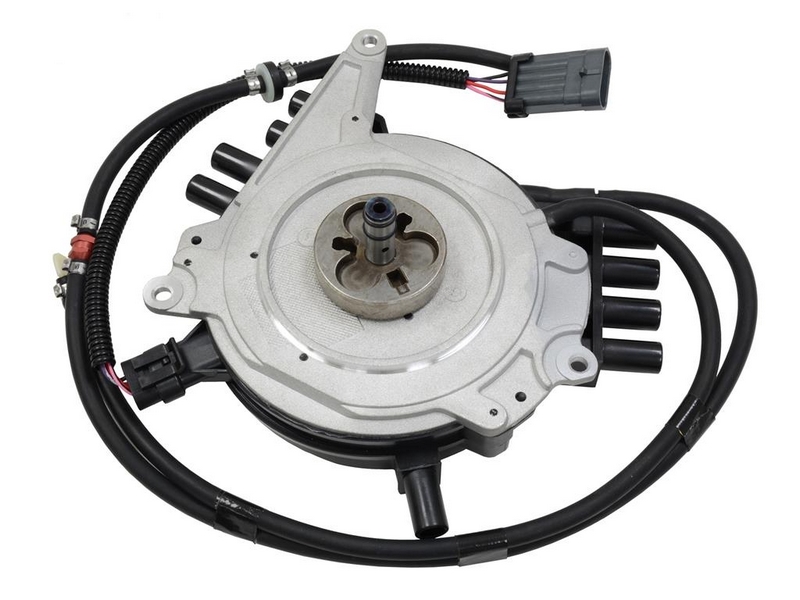
We’ve already addressed the issues with the LT1’s OptiSpark ignition system above. However, when looking at purchasing a 1992–1996 Corvette, one of the first questions that should always be asked is “has the OptiSpark unit been replaced?” It is worth noting that failure of the OptiSpark system was more common in the 1992 and 1993 Corvettes. By 1994, the OptiSpark units had been redesigned to provide better moisture venting. Remember that a compromised OptiSpark ignition system is one of the most common culprits of rough-engine and no-engine start for these cars.
A failed fuel-pump relay is also another common culprit on the C4 Corvette that prevents it from starting. This issue is more common on pre-1990 Corvettes although it has impacted all model years of this generation. Many experienced C4 Corvette owners carry at least one spare fuel pump relay to avoid getting stranded by their car in the event that it fails while they’re out driving.
The Cooling System
When evaluating a prospective C4, always ask the current owner to start the car and allow it time to warm up long enough that the thermostat opens and the cooling fans turn on. The electric fan relay on these cars has a tendency to fail, which will result in engine overheating. Additionally, the C4 Corvettes (all years) are known to develop coolant leaks and is actually considered a fairly common problem today. Check for oil in the radiator fluid. If the engine has an internal coolant leak, the coolant may look murky, orange-brown in color or have specs of oil floating in the coolant.
It should be noted that the “LOW COOLANT” light on the dashboard is prone to illuminate, even when the car’s cooling system is completely full. This is generally the result of a faulty coolant temperature sensor. When looking at any C4 Corvette, don’t be afraid to ask the owner if the car has had any coolant leaks. If the system is full and no leaks are visible, then its probably the coolant temperature sensor.
Wheel Bearings/Hub Assembly
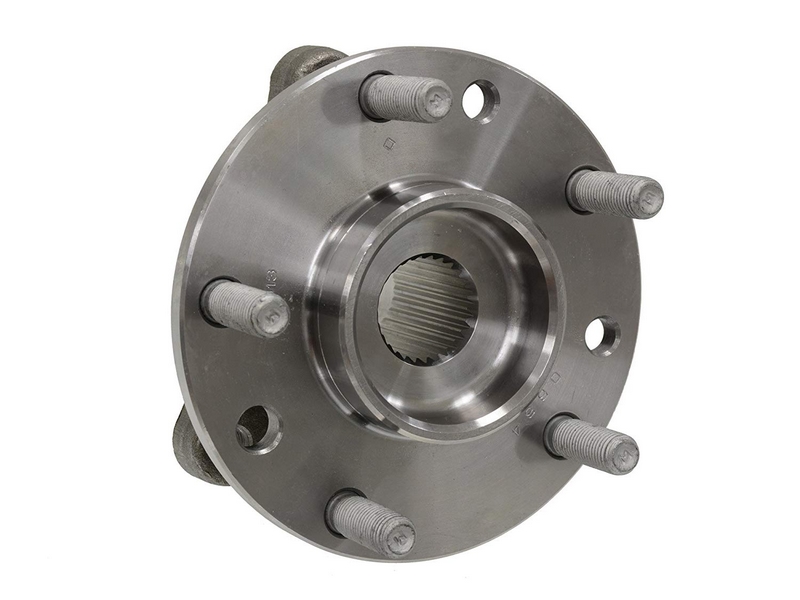
When reviewing maintenance records, asked the seller when the wheel bearings were last serviced. The C4 Corvette used sealed hub assemblies and they were notorious for wearing out prematurely. If they haven’t been replaced recently, it is advised that they’re inspected prior to purchase. It’s also recommended that they’re replaced before they fail as they can cause a wheel to seize, leaving the driver stranded.
Rear Axle
Earlier-generation (pre-1990) C4 Corvettes are known to develop leaks at the rear axle. As with the wheel bearings, look at the vehicle maintenance records and verify whether or not the rear axle was serviced in the car’s lifetime. If it hasn’t been, it is advised that the rear axle is inspected prior to purchase.
Carpets and Seat Upholstery
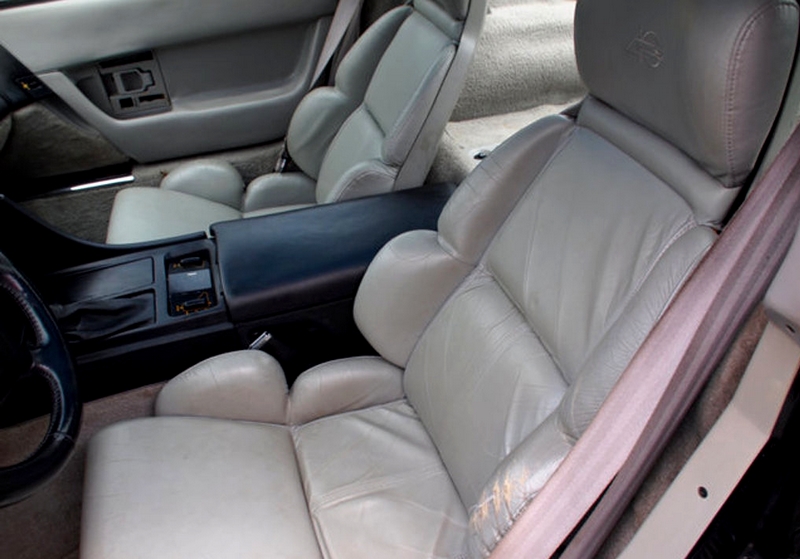
The carpet and seat upholstery of any car will wear out over time, but given the extremely low ride height of a Corvette, the driver seat and carpeting tends to take a bit more abuse than in other, more conventional vehicles. As such, it is worth inspecting the condition of the carpeting for wear or extreme discoloration. It is also worth thoroughly inspecting the condition of the seats, most especially the driver’s outside bolster. On older Corvettes, the bolsters are known to split open (the stitching wears out) or tear (the leather becomes dry and brittle) creating an unsightly appearance to the seat. While this does not affect drivability, it nonetheless takes away from the aesthetic of the car, and so finding a Corvette whose interior has been properly maintained (including treating the leather with conditioner on a routine basis) will help ensure that the car being purchased continues to look good long after pink slips swap hands.
Electronics/Dashboard
The C4 Corvettes are notorious for having electrical issues, especially on Corvettes built from 1984 to 1989. These earlier examples of the fourth-generation Corvette utilized an all-digital, electroluminescent instrument panel/dashboard. While the technology was definitely cool when new, it was also developed during a time when this type of technology was brand-new and more prone to failure. As such, take time to verify operability of the entire dashboard. Toggle thru all of the different options and make sure that all buttons and gauges are working.
Do the same with all power windows, locks and latch release buttons. Lastly, verify that the pop-up headlights function as intended – and take the time to test them several times. Replacing the drive motors on the pop-up headlights is expensive. By taking the time to review/verify operability of all the car’s features, you’ll potentially avoid an expensive repair bill later.
Airbag Warning Light
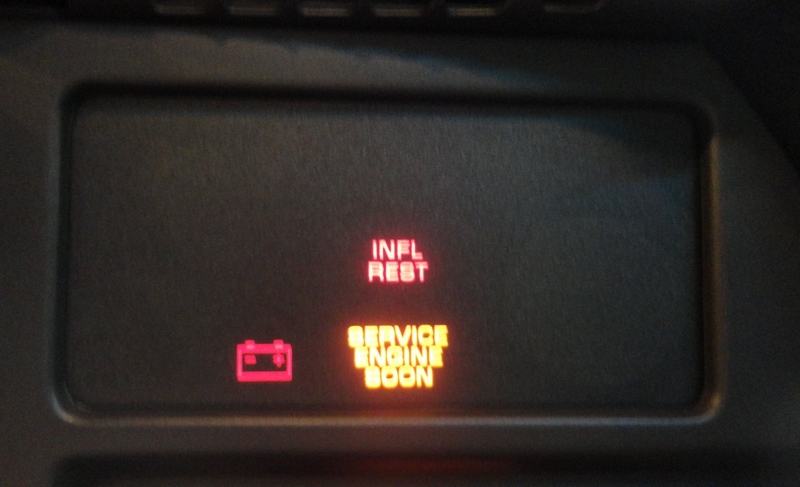
On C4 Corvettes equipped with airbags, the airbag warning light may remain illuminated. Look for the “INFL REST” light when inspecting the dashboard during your inspection of the vehicle. In the event that this light remains on during operation, it is often an indicator that an airbag sensor has failed. The airbag warning light is often accompanied by the safety-belt warning light as well, so look for either/both to remain illuminated after the initial start-up/ignition-on process of the Corvette.
Tilt Steering Column
For some Corvette owners, the steering wheel serves a secondary purpose – it becomes a means of pulling ones self out their Corvette. Because this puts undue wear on the steering column, it has also become a common fail point on older Corvettes. When inspecting the vehicle, take a moment to pull down on the steering wheel towards the 7 o’clock position. If the steering wheel makes any noise, it if feels loose or if the steering wheel jiggles in your hand when going over bumps/uneven terrain during a test drive, it is likely that the steering knuckle is worn out and will need to be replaced.
What To Look For Once You Start the Shopping Process
Exterior Inspection
Remember the earlier discussion about uni-frame construction? The C4 also ushered in a new era of material and body assembly. The body panels on the C4 Corvette are considered “non-structural” (think cowlings on a sport-bike/motorcycle) and are attached (by adhesives in many instances) to the drivable space frame. When inspecting the body panels, make sure that the fitment of the panels and the gaps between panels are uniform. If any panels appear to be misaligned, or if the gaps are pressed together, this could be an indicator that the car was involved in an accident.
In addition to body panel fitment, take the time to have the car lifted so that an undercarriage inspection can be performed. While the body panels on the Corvette are constructed of fiberglass, the frame and sub-assemblies are not. It is important to inspect these area for damage and frame integrity. It is also important to keep an eye open for rust/corrosion. While lifted, you’ll also have the opportunity to do a visual inspection of the internal side of the lower body panels as well.
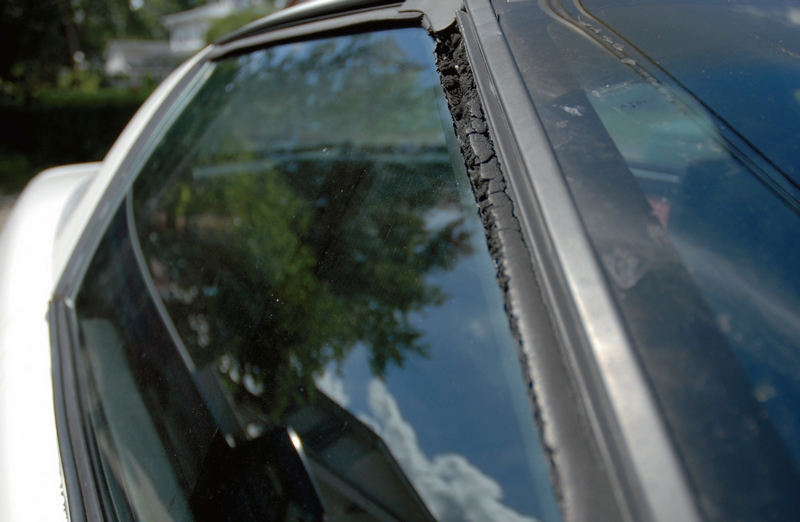
Take time to inspect the removable targa-top on coupes and the overall condition of the fabric and sub-structure of the top on convertible models. On targa tops, inspect the panel for cracks, especially where the mounting hardware is attached. Check the weatherstripping around the top and make sure that they’re soft and pliant. Dry or brittle weatherstripping will cause significant leakage into the car’s interior.
Hood Alignment
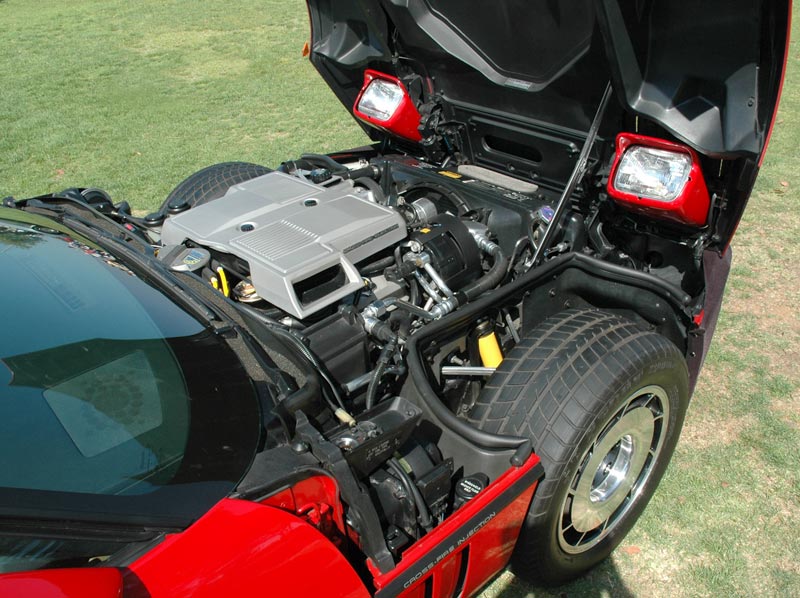
On the fourth-generation Corvette, the clamshell hood is the single largest body panel on the car. It comprises the entire hood of the car as well as the upper half of the front fenders. As part of the car’s visual inspection, it is imperative that the clamshell hood be opened, not just to inspect the engine beneath, but to ensure that the hood operates (opens and closes) as intended. Any C4 Corvette that has been involved in a front-end collision will likely have an alignment issue that causes the hood to be difficult to open and close. Verify that the hood latches/unlatches easily, without a lot of force on the latch-release mechanism located on the underside of the hood near the driver’s door.
Verify VIN (Vehicle Identification Number) and Motor Numbers/Stamping
This is a fairly straight-forward process and fairly easy to-do. You’ll need the VIN number for the next step anyway, so taking time to familiarize yourself with the vehicle identification number and engine codes will help ensure you’ve got an unmolested/unaltered Corvette. To help you in this process, Corvsport.com has all of this information available for you on our website. To review/understand the breakdown of the VIN information by year, click here. For a more detailed breakdown of the VIN, including engine and transmission numbers/stampings, please visit the individual model-year pages by selecting the model year you are considering below:
| 1984 Corvette | 1985 Corvette | 1986 Corvette | 1987 Corvette | 1988 Corvette | 1989 Corvette | 1990 Corvette |
| 1991 Corvette | 1992 Corvette | 1993 Corvette | 1994 Corvette | 1995 Corvette | 1996 Corvette |
Order a Vehicle History Report / Get a Used Car Check
An important step in researching any used vehicle is to know the car’s service and care history. In today’s world, there are a number of reputable companies out there that can provide you a comprehensive and detailed review of any vehicle you might be looking to purchase. All you need to get started is that vehicle’s VIN number. Companies such as CARFAX, Autocheck (and others) can provide you with a detailed history of your prospective vehicle, including: major accidents, open recalls, total loss, airbag deployment, service history, estimated miles driver per year, multiple owners, registration history, rebuilt title, mileage rollover, hail damage, last reported mileage, vehicle service, mileage rollback, warranty information, branded a lemon, length of ownership, structural damage, state owned, flood damage, salvage titles, junked and whether it was used for commercial (such as rental car agency) or personal use. Most reports cost less than $50.00. While they may not tell you everything about the car, they definitely provide you a snapshot of the car’s history. This may help you make a more informed decision before investing any significant time or effort into that particular vehicle.
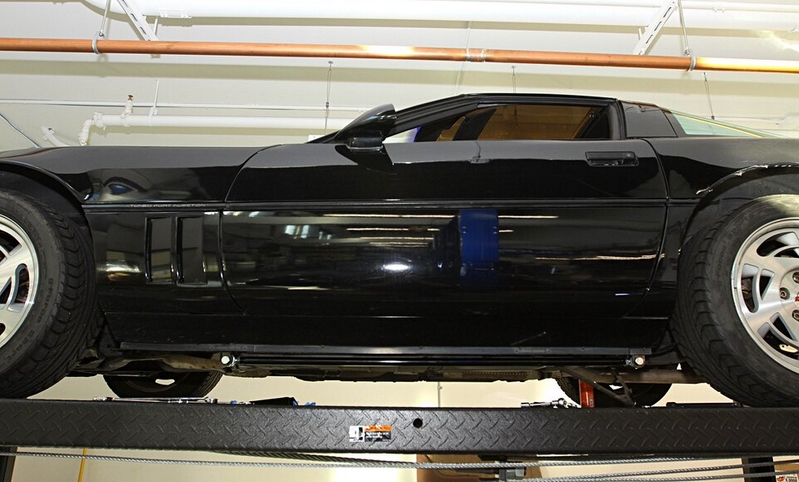
In addition to the vehicle history report, take the to have the car checked by a reputable mechanic (either at a dealership or trusted service garage). Allow them to check the vehicle’s fluids, perform a compression test on each of the cylinders, check the brakes, the steering linkage, the cooling and electrical systems and the safety restraint/airbag systems to ensure that everything on the car is as it should be. While you’ll probably have already inspected a number of these items yourself, having a trained professional verify your findings will provide you with a greater peace of mind before handing over your hard-earned dollars for a used sports car – even one as nice as a Corvette!
Test Drive
After you’ve done all of your homework, its time to get your prospective Corvette out on the open road. The test drive will allow you to experience the car in a way that no inspection ever could. It will help you determine whether or not the car is a good fit for you as a driver. Even a perfectly maintained Corvette isn’t going to be of value (or enjoyment) to you if you aren’t comfortable driving it. For some prospective owners, a C4 Corvette might sit too-low-to-the-ground, or the cockpit might seem too compact (keep in mind these cars are all two-seat sports car with no backseat and limited storage space, especially in the convertible models.) For others, the ride may be too harsh, or the exhaust and/or road noise might be too loud.
It is important to remember that the C4 Corvette evolved considerably from its introduction in 1984 to the end of its production in 1996. As previously stated, the suspension was refined throughout the car’s lifespan as was its creature comforts. We recommend you drive several different examples – while they’re all based on the same platform, you’ll be surprised how different each year is from the others.
Also, the test drive is another means of checking the car’s operability. When driving the car, don’t allow the passenger (which will probably be the car’s current owner) spend the entire drive talking at you or with you. It is important that you listen to the car. Pay attention to any clunks, engine or transmission noises. Also, take enough time to really put the car thru its paces. Observe if the car wants to pull to the left or right. Be intentional about testing the brakes and the steering. If it is a manual transmission, pay attention to when the clutch begins to catch – if it’s got a high clutch pedal, it could indicate that the clutch is worn out. Look for smoke coming from the exhaust or beneath the hood and pay attention for any unusual smells – such as burning oil or engine coolant.
Take Your Time
For most of us, buying a Corvette is an emotional experience. It’s a promise that many of us make to ourselves when we see our first Corvette that “someday I’m going to have one of my own.”
If you are in the market to buy your first (or next) Corvette – CONGRATULATIONS! This is an exciting time for you, and it is understandable that you’d want to find the “perfect” car to bring home and have for evermore. However, you must practice patience when shopping for a used Corvette. Just as you dream of drifting thru the corners and tearing up the straightaways at (insert favorite local race track here), the people who purchased the cars you are now looking at dreamed the same dreams. As such, finding the right Corvette is a little different than buying a “daily driver” that you’d use for your commute back and forth to work. These cars are driven harder, faster and often with less regard to the wear and tear than to the exhilarating experience of flying thru a sharp turn just a little too fast.
Because of this, you’ll want to follow all the steps we outlined in this article. You’ll want to keep emotion out of the decision making process as much as is humanly possible. That’s not to say you shouldn’t enjoy the experience, but be informed and purchase a Corvette that passes all these search criteria so you’ll have as much enjoyment with your Corvette after you make the purchase as you did finding it in the first place. It is also worth noting that shopping for a Corvette can be a lot of fun! You’ll definitely get to drive some amazing cars along the way…and here’s where you should embrace and enjoy the journey of finding the “perfect Corvette.” If nothing else, you can be certain that when you do finally make your big purchase, you’ll have found a Corvette that is perfect for YOU.
What Are These Cars Worth?
The used collector’s car market is a difficult thing to measure in terms of vehicle values. Every sports car on the market today will have significant swings in its market value based on a number of varying factors including: long-term reliability, availability and demand of next-generation models (this one has a huge impact on Corvettes of all generations), rarity of particular options within a particular series of cars (such as paint color/interior color combinations, included options, limited edition models, etc.)
When trying to valuate what a used Corvette’s “worth” is, there are a number of approaches that can be taken. Fortunately, the internet has taken some of the mystery out of the valuation process because it allows would-be consumers the opportunity to look at cars across the nation (and even around the world) and compare prices in real time. It is a worthwhile exercise to get online and spend time shopping at reputable automotive websites such as AutoTrader, CarGurus, Craigslist and the like. These websites will allow you to narrow down your search to a specific model, geographic area or even by specific options that are important to you as a consumer, and the compare hundreds of similarly equipped cars that are all prospective options for purchase.
Having said all that, we’ve provided you an estimated range of what used C4 Corvettes are selling for in today’s market. Please take note that these price ranges are accurate as of Q4, 2019, and that they reflect actual market price range based on collected data from a reputable used car website. We based our search criteria on availability across the United States as well as limiting our search to a Corvette equipped with less than 75,000 miles, an automatic transmission, and standard options.
- 1984 Corvette – $4,000 to $7,100
- 1985 Corvette – $6,000 to $12,900
- 1986 Corvette – $4,600 – $15,000
- 1987 Corvette – $7,000 – $19,907
- 1988 Corvette – $7,000 – $19,995
- 1989 Corvette – $5,800 – $18,900
- 1990 Corvette – $7,000 – $23,900 (excludes ZR-1)
- 1990 ZR-1 Corvette – $14,995 – $27,995
- 1991 Corvette – $5,587 – $19,950 (excludes ZR-1)
- 1991 ZR-1 Corvette – $21,900 – $24,200
- 1992 Corvette – $9,300 – $18,999 (excludes ZR-1)
- 1992 ZR-1 Corvette – $23,900 – $24,800
- 1993 Corvette – $5,995 – $27,000 (excludes ZR-1)
- 1993 ZR-1 Corvette – NO DATA AVAILABLE
- 1994 Corvette – $7,588 – $37,000 (excludes ZR-1)
- 1994 ZR-1 Corvette – NO DATA AVAILABLE
- 1995 Corvette – $5,999 – $29,995 (excludes ZR-1)
- 1995 ZR-1 Corvette – $23,000 – $36,999
- 1996 Corvette (includes Grand Sport) – $7,950 – $40,900
Remember that these price ranges will vary based on geography and vehicle specific options. We STRONGLY ENCOURAGE utilizing resources like Kelly Blue Book (kbb.com) to get a better valuation on the car (or cars) you are looking to purchase. KBB will provide you with market data specific to your local geographic location as well as market price value based on important criteria like mileage, specific vehicle options, vehicle condition, etc.
Good Luck and Happy Hunting!
We hope this buyer’s guide helps you navigate the exciting (and sometimes challenging) prospect of purchasing a used C4 Corvette. While we’ve identified a number of items to watch out for, we also want to make sure to remind you that all of the items listed in this buyer’s guide are based on individual issues experienced at different times by Corvette owners over the course of many years. While there’s probably that “basket case” Corvette out there that is plagued with multiple issues, most Corvettes (especially those that have been maintained) will provide their owner with many happy years. Additionally, it is important to recognize that any car which maintains its value (as listed above) this many years after being sold as new is most definitely a worthwhile investment.
Remember, half the fun is the experience of hunting for the perfect Corvette. We wish you every success in your search and hope you’ll drop us a line at Corvsport.com after you purchase your C4 Corvette. Good luck and happy hunting!


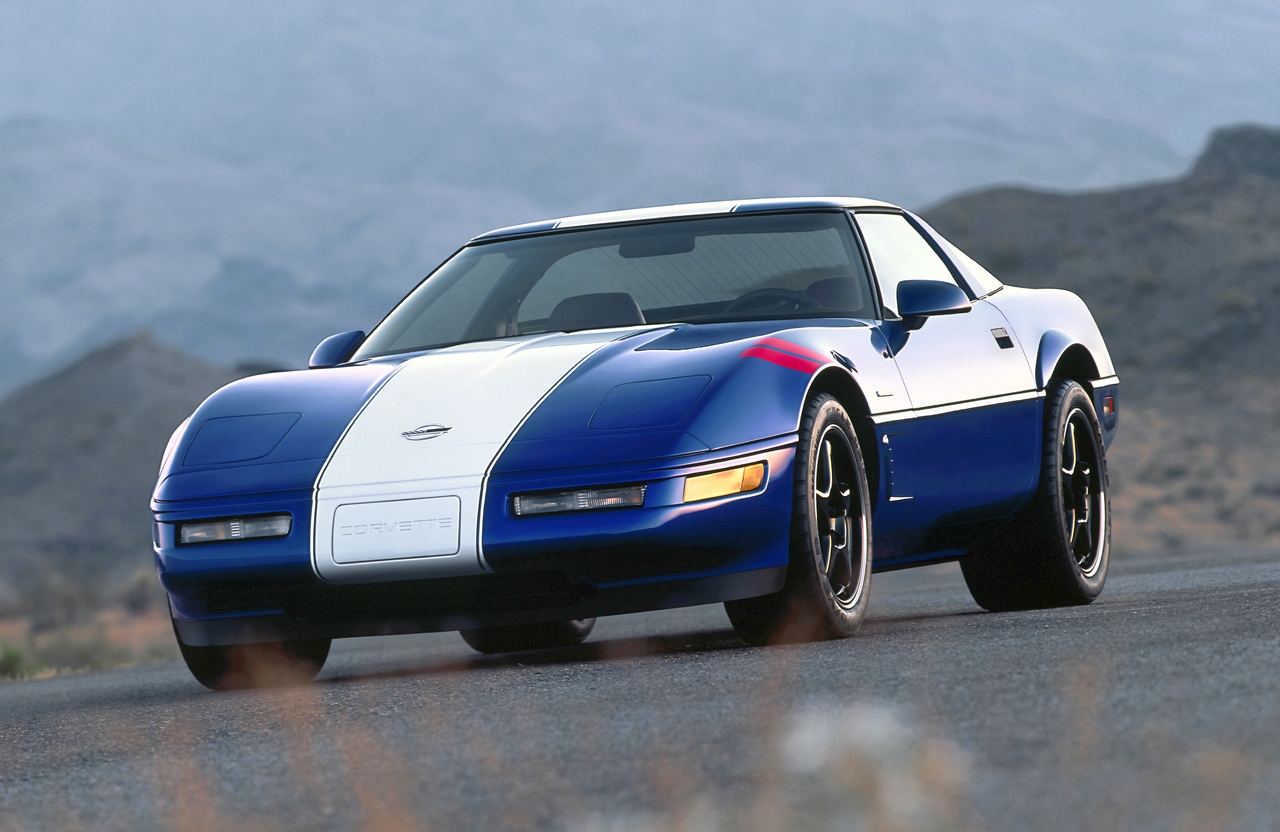
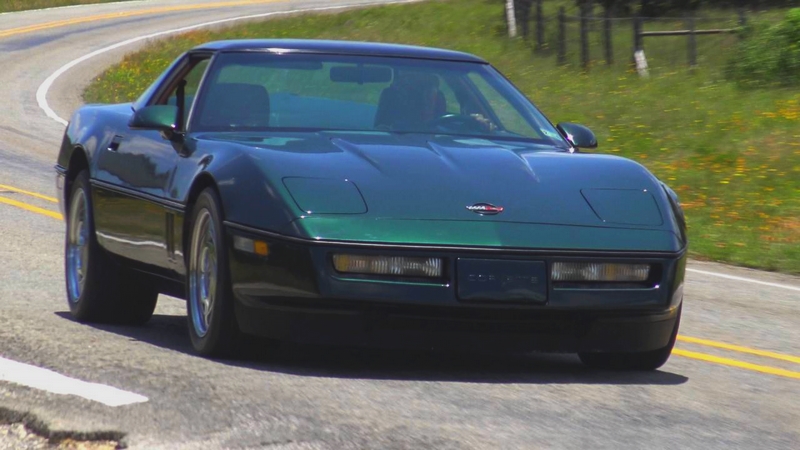
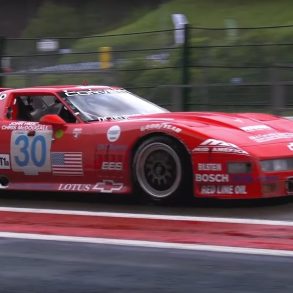
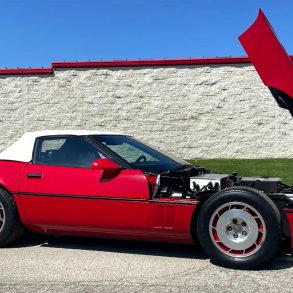


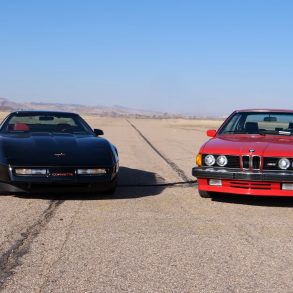
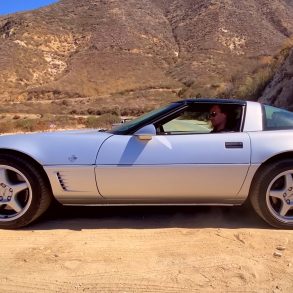
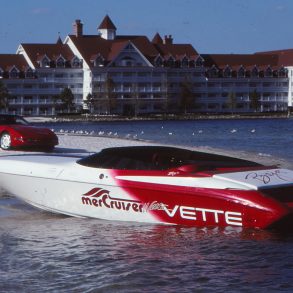
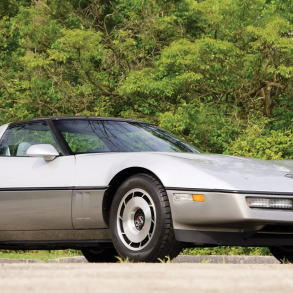

Nice work, a lot of great information. As the owner of a 1990 ZR-1,its cool to know that no other corvette has not and probably never will break the 24 hour world speed endurance record like the lowly C4 ZR-1 did in showroom stock form and also limited to 70% WOT,and carried 300 lbs. of spare parts also. I highly doubt any push rod engine could stay in one piece in such an attempt. It took a prototype VW W-30,12 cylinder non mass produced car to break that record, so technically the 1990 ZR-1 still holds that record for mass produced car with all the creature comforts aboard. The C4 even in L98 trim still holds records.
Michael, thanks much for the feedback! The C4 ZR-1 is definitely something special, and I appreciate your comments about the car. We didn’t include this information in the buyer’s guide but if you visit our individual model year pages, I believe we discuss the accomplishments of this amazing car. If you’ve got any pics you’d like to share of your Corvette, we’d certainly love to see them. Please feel free to share them on our Facebook page or you can email them to [email protected].
Michael…great infl contained herein…just one thing, though…
…ALL legitimate dealers and every bank I have known does NOT use Kelly Blue Book, but 8nstead NADA Older Car Value Guide figures…particularly after KBB got caught fudging valuatioms of a number of high-end cars in exchange for big $$ payola…
…their reputation has basically ” been mud” ever since…
…just an FYI from a former Bank St. V.P….
Great article, but the year when the new vented Gen-2 Opti-Spark was put on the C4 is incorrect. In the article above it states that 1992-93 had the old style “non-vented” Gen-1 and that the new “vented” Gen-2 style came in 1994. That is INCORRECT! The non-vented Gen-1 was used from 1992-94! The newer vented Gen-2 wasn’t introduced until the 1995 model year. This should be edited and fixed as it is a fairly *major* inaccuracy and could lead people astray, especially for a “C4 Buyer’s Guide” on a otherwise excellent Corvette website.
Thank you for providing important information about corvettes historical inventions of all models especially the C4 models very informative,I own 3 corvettes i have a 1978, 1987 and just pured a 1991 corvette.
Your photo that indicted a LT1 motor is actually a LT4, other than that great artical
I have a 1993 Chevrolet Convertible Corvette that is Aqua blue with 93k miles on it with. It as new waterpump, new convertible top and is in Great condition. I am asking $11,500 if you are interested please email me, I live in the Northern Panhandle.
[email protected]
Nice to see the Copper Metallic representing ’94 Vettez! I have 2 of them….😉
Greetings, I’m Bill USN (ret.), I bought my first Corvette while in the Philippines. I’ve had bad experiences dealing with people who wants to help but failed. Corvette parts are not common in the country, and if there are hoarded parts they are expensive. My ’84 Vette is staged in our house in Tagaytay city in the Philippines. Most of the main issues are in the cooling system department. It overheats, most of the parts in the cooling system have been replaced, but the overheating issues remained constant. My dashboard cluster is shut. Is there anybody out there who can help? Thanks and happy holidays to all.- BILL
I translated the whole article for myself in Hungarian. The translate was 4 months at least for me.